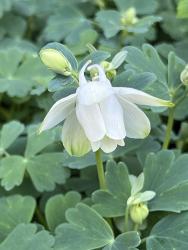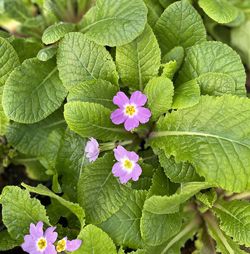Including Aquilegia, Aruncus, Aster, & Astilbe
“Among the most beautiful of hardy flowers,” William Robinson once proclaimed about this robust easily grown Lily kin. And we whole-heartedly agree! Endemic to both Turkey and southern Europe’s mountain meadows, rocky fields and open woods, Anthericum liliago’s tuberous roots nourish a tidy low-growing grass-like clump of long slender green foliage. Ebullient yellow anthers spangle the starry white blooms that populate spike-like clusters atop lithe, 2 ft. tall leafless stems. Relishing warm sunshine, good drainage and rich adequately-moist soil, St. Bernard’s Lily can slowly naturalize along garden paths and enchant perennial borders, rockeries or cut arrangements.
Blooms May–June
Size: 18" – 2' 0" high x 12" wide.
Hardy to zone 6.
Anthriscus
Cow Parsley
Anthriscus sylvestris ‘Ravenswing’ (P-1201)
Each $11.25
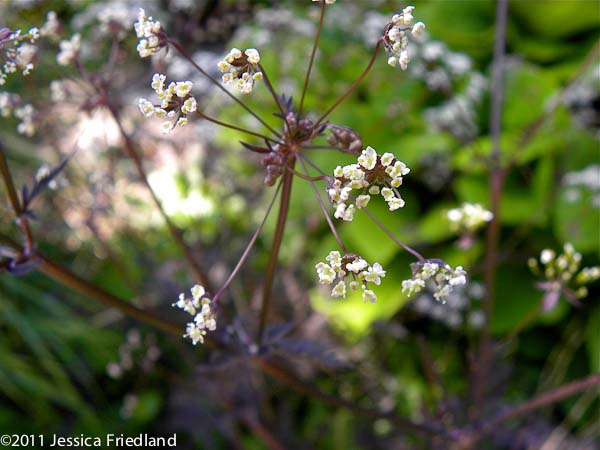
Esteemed for its dark coloring, Cow Parsley
offers a layered 18 in. rounded stand of luscious, fern-like bronzy plum-colored foliage. In early summer, branched flowering spikes hold airy umbels defined by small white flowers and pink bracts. Surround this beauty with Aster ‘Bleke Bet’ and Berberis ‘Concorde’ for an opulent blend of purple leaves. Keep the blooms trimmed back to ensure a comely habit.
Blooms July
Size: 2' 0" – 2-1/2' high x 18" – 2' 0" wide.
Hardy to zone 8.
Antirrhinum
Perennial Snapdragon
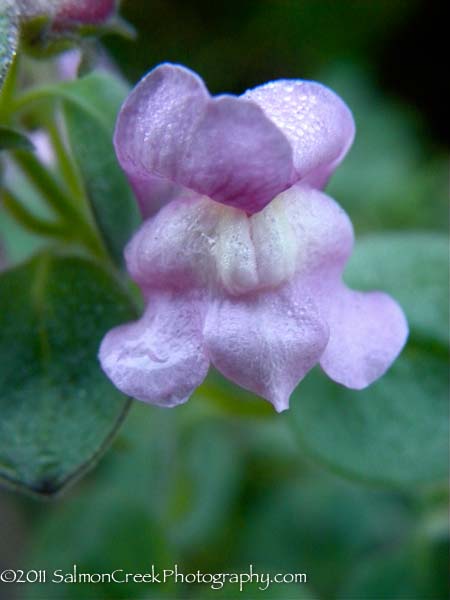
Awash with pastel charm, droves of pale pink flowers pose all summer long atop a low growing silvery bluish green mound that can take the heat. Perfect for a stone wall or along a pathway, this carefree perennial easily links stronger colored plants, while its thin curvy stems clad in glaucous, round downy leaves crave a bright, sheltered well-draining cranny.
Blooms June–mid-September
Size: 12" – 15" high x 12" – 15" wide.
Hardy to zone 5.
Antirrhinum sempervirens (P-1169)
OUT OF PRODUCTION AT THIS TIME
Email me when this plant is available
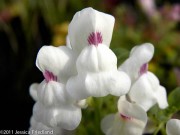
A soft, evergreen palette of silky-haired, gray-green leaves and trailing, fuzzy silver stems set off the glistening, uplifted racemes of creamy blooms. Each two-lipped blossom is accented with a pale yellow throat striped in lilac.
Exhibiting a fortitude for dry conditions and a small mounding presence, this pretty bushlet is ideally suited to the rockery or along a path where it soothes rough edges, and can be accompanied by Diascia ‘Coral Canyon’ and Nepeta ‘Select Blue’.
Blooms June–July
Size: 6" – 8" high x 12" – 18" wide.
Hardy to zone 7.
Aquilegia
Columbine
This genus deserves its lofty names, which mean “eagle” and “dove,” because its intricate flowers have been said to resemble birds in flight. Beyond the symbolism of the flowers, the finely textured, widely varied species possess a gracefulness that is likely to carry you to heights of enjoyment. Whether trim dwarfs or fancy long-spurred varieties, Columbines are characterized by fern-like 3-lobed leaves. They are best suited for naturalizing in a woodland with dappled light, however the smaller species will thrive in a partially shaded garden bed.
Traversing the subalpine meadows of Europe’s Alps and Apennines mountains, this tall arresting species flaunts nodding dark purple blooms with short spurs and prominent yellow stamens, which stretch well beyond the rich-as-velvet nearly black petals. Strong lanky stems anchor the mesmerizing blooms, while the handsome glaucous greenery provides contrasting foliar hues for Hakonechloa macra ‘Aureola’ and Lysimachia ‘Aurea’.
Blooms April–early June
Size: 18" – 20" high x 12" wide.
Hardy to zone 3.
Aquilegia buergeriana ‘Calimero’ (P-0918)
Each $11.25
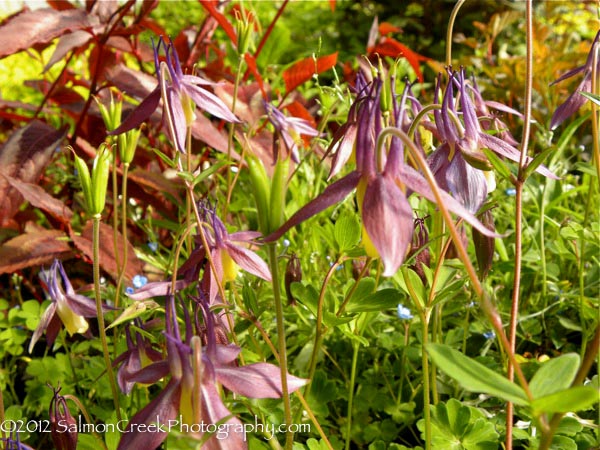
Dangling like delicate Japanese lanterns, the plum and soft yellow blossoms are topped with wispy, tapered spurs that curve inward. Like an ideal small-space ornament, this compact Aquilegia offers a demure mound of foliage and arresting colors.
Blooms May–mid-June.
Size: 8" high x 8" – 10" wide.
Hardy to zone 6.
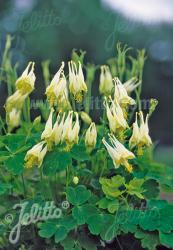
Discovered by Lawrence Clemens near Corbett, Maryland and first introduced by Bluemont Nursery, this delightful chance seedling of the native eastern species parades nodding lantern-shaped creamy-yellow flowers with notable stamens and long spurs aloft short slim stems. Dainty 3-lobed green leaves craft a slightly more compact habit, which is reputed to be longer lived than many other Columbines. A popular destination for bumblebees and Ruby-throated hummingbirds, ‘Corbett’s floriferous pastel-hued display can brighten cottage gardens, sun-dappled rockeries, steps and pots, while tucked among spring bulbs or alongside Pulmonaria ‘Bertram Anderson’ and Epimedium ‘Dark Beauty’.
Blooms April–May
Size: 12" – 18" high x 15" wide.
Zone 3/4.
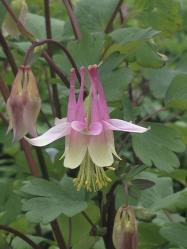
Discovered by Kansas’ Dyck Arboretum of the Plains and introduced by Jelitto Seeds, this superb softly hued gem is shorter than its wild eastern cousin. The nodding, small-spurred blooms dress up with pretty pink outer petals, encompassing a buttery-yellow corolla. All this floral delight tops refined 3-lobed ferny foliage that can be nestled amid Pulmonarias or Helleborus.
Blooms May–July
Size: 10" – 12" high x 10" – 12" wide.
Hardy to zone 3.
Aquilegia chrysantha ‘Denver Gold’ (P-1742)
Each $11.25
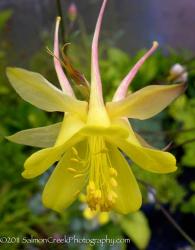

Bathed in brilliant golden yellow hues, fragrant extra large blossoms, some reaching over 3 in. across, achieve an elegant grace note as long tapered recurving spurs stream from behind. Promising a repeat bloom with attentive deadheading, the blithe open flowers are borne on well-branched stems above a compact ferny mound of lobed bluish green leaves. The native species, Aquilegia chrysantha, wanders throughout the southwestern U.S. and northern Mexico, while this robust Plant Select introduction brings an illuminated show to woodland gardens, the rockery and even a cut bouquet.
Blooms April–May
Size: 2-1/2' high x 15" wide.
Zone 3/4.
Aquilegia chrysantha ‘Yellow Queen’ (P-1168)
Each $11.25
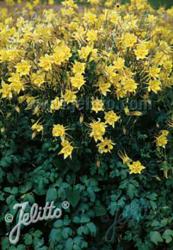
As if in flight, ‘Yellow Queen’s long outward-curving spurs trail behind its cheerful, bright yellow flowers. Soaring on tall slender stems above bushy and bluish green, fernlike foliage, the upfacing, fragrant blooms are good-sized and abundant. Owing its vigor and floriferous nature to its wild southwestern cousin, Aquilegia chrysantha, this cultivar makes a sunny partner for the lush purple leaves of Anthriscus ‘Ravenswing’.
Blooms April–May.
Size: 2-1/2' high x 15" wide.
Hardy to zone 4.
Aquilegia flabellata ‘Blue Angel’ (P-1057)
Each $11.25
Promising plenty of nodding vivid blue-violet flowers brightened by white centers, this hearty Columbine forms a tidy low-growing mound with lobed deep green foliage. Cozied along a stone wall or garden path, ‘Blue Angel’ bestows enchanting detail.
Blooms April–early June
Size: 8" high x 10" wide.
Hardy to zone 4.
Aquilegia flabellata ‘White Angel’ (P-2258)
Each $11.25
Aquilegia ‘Heavenly Blue’ (P-2198)
Each $11.25
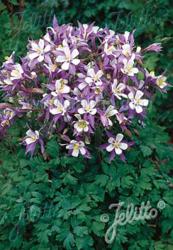
Large long-spurred blooms and overall classic good looks set this exquisite cottage-garden favorite apart. Enlivened by glowing white centers with yellow stamens, the divine upward-facing sky-blue flowers float above a vigorous foundation of natty fern-like foliage. ‘Heavenly Blue’ can festoon a bouquet or dwell in well-drained sites beside Aquilegia ‘Yellow Queen’ for a cheery color combination that’s reminiscent of ProvenÇal table linens.
Blooms May–July
Size: 2' 0" – 2-1/2' high x 15" wide.
Zone 3/4.
Aquilegia vulgaris ‘Heidi’ (P-2130)
Each $11.25
Introduced more than 25 years ago by Jelitto Seeds, this sturdy German cultivar is a beacon of loveliness. Long, upstanding branched stems cushion the plethora of nodding salmon-pink blooms above glaucous blue-green foliage. ‘Heidi’ is ideal for garnishing your next bouquet or teaming with Brunnera ‘Mr. Morse’ or Ajuga ‘Black Scallop’ in a bright, yet not too sunny nook.
Blooms May–July
Size: 2-1/2' high x 15" wide.
Zone 3/4.
Each $11.25
Each $11.25
Inhabiting haunts from southern Russia to northern Turkey plus Iran, this tall growing hummingbird mecca offers 2 in. wide blooms with cupped white petals, brilliant blue sepals and short, markedly hooked pale spurs. The cornucopia of fanciful blooms, perched upon wiry stems, gazes down at fine-cut glaucous greenery. Hard to find and easy to grow, Aquilegia olympica promises a pleasing foliar effect throughout the season, while positioned alongside Epimedium ‘White Queen’ and Helleborus ‘Joseph Lemper’.
Blooms May–early July
Size: 18" – 2' 0" high x 12" – 18" wide.
Zone 3/4.
Each $11.25
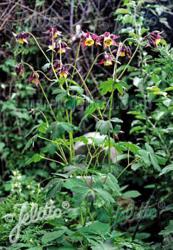
Initially described in 1856 and named for its long prominently pointed sepals, this comely Columbine cavorts the open forests, rocky slopes and exposed meadows of Europe and northern Asia. Attractive rounded green leaflets plus slender nimble stems give way to nodding blooms that feature maroon sepals, short-hooked spurs and creamy-yellow inner petals. Coveted by butterflies, hummingbirds and cut flower enthusiasts, Aquilegia oxysepala snubs bunnies and deer, while enjoying sunny, dry to moderately moist nooks with good drainage.
Blooms May–July
Size: 2' 0" – 2-1/2' high x 12" – 15" wide.
Hardy to zone 5.

Some 75 years ago, Joseph Rock gathered seed from this classy perennial in China’s Szechwan kingdom. Elevated on stems that mimic a dancer’s grace, the pendent flowers are lavishly colored in deep lilac shades. White-edged corollas embellish the large, short-spurred blooms above a pleasing foliar mound.
Blooms May–June
Size: 15" – 20" high x 12" wide.
Hardy to zone 6.
Each $11.25
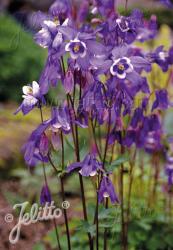
Hailing from central Asia, this splendid species beckons us with large, dazzling deep blue flowers described by short spurs and clear white corollas. The nodding, hummingbird and butterfly-friendly blooms reside on graceful 14 in. stems above a cold-hardy blue-green mound of attractive rabbit- resistant leaves. Happiest in fertile soil and coastal sun, or bright shade elsewhere, Aquilegia sibirica can be tucked into troughs, rock work or alpine gardens.
Blooms May–June
Size: 14" high x 10" – 12" wide.
Hardy to zone 3.
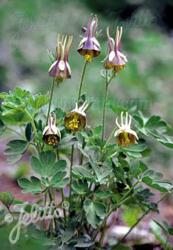
For its early blooming, uniquely hued flowers plus fine-cut appearance, this sweetly perfumed 1902 heirloom was recently nominated Plant of the Month by the North American Rock Garden Society. The compact cold-hardy mound of biternate blue-green foliage supports nodding clustered flowers with zingy chartreuse anthers, plum-flushed pale green sepals and purplish cocoa-colored petals topped by short straight spurs. Native to eastern Siberia, Japan and western China, Aquilegia viridiflora sprouts violet-tinged new growth, entrances the pollinators plus lends a dainty softness to rockeries and cottage gardens.
Blooms April–June
Size: 16" – 20" high x 12" wide.
Hardy to zone 3.
Aquilegia vulgaris plena ‘Ruby Port’ (P-0428)
Each $11.25
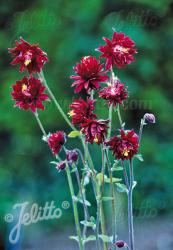
Exhibiting the easy elegance that assures Columbine’s well-known charm, exquisite short-spurred, double flowers festooned in deep ruby-red hues rest atop long, sturdy stems like lazy nodding bells. Sumptuous against a winsome clump of bluish green ferny leaves, the blooms create an intoxicating color echo when combined with Epimedium x rubrum’s red blossoms and the dark foliage of Heuchera ‘Taffeta’.
Blooms May–June
Size: 2' 0" – 2-1/4' high x 15" wide.
Zone 3/4.
A shining star of the cut flower trade, ‘Blue Barlow’ prances elaborate, fully double deep violet-blue blossoms—upward-facing, spurless and nearly 2 in. across—on tall lithe stems. Grayish blue-green divided foliage shapes a tailored lacy mound below the plush, long-lasting Dahlia-like inflorescences that everyone adores, especially hummingbirds and butterflies. Ideal for bright dappled recesses, this uniquely beautiful Columbine appreciates well-drained, compost-rich soil and a cutback after the blooms are spent.
Blooms May–July
Size: 2-1/2' high x 18" wide.
Hardy to zone 3.
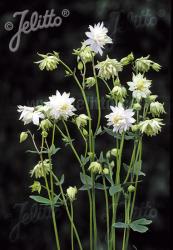
Steeped in a Granny Smith apple-green hue, the new ferny leaves plus nodding flower buds set the stage for unique, green-rimmed, creamy-white double blossoms. The spurless, multipetaled flowers initially transmute luminous green tones, later adopting a wide flattened appearance, enhanced by starburst-like points. The epitome of ornate elegance, ‘Green Apples’ can grace a vase, enliven a cottage garden or be utilized as a foil for fading spring bulbs.
Blooms May–July
Size: 2' 0" – 2-1/2' high x 18" wide.
Hardy to zone 3.
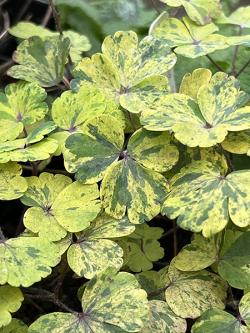
A merry union of speckles, splotches and streaks in Irish green, chartreuse and golden hues embellish each marbled leaf, rendering no two alike. Spurred deep purple pendulous flowers, poised on tall slender rosy stems lend splendid dark accents. Deemed the most treasured of variegated Aquilegias, this colorful Jelitto Seeds introduction gilds a shady nook, while a hard trim after blooming refreshes its leafy clump.
Blooms April–May.
Size: 2' 0" high x 15" wide.
Zone 3/4.
Aquilegia vulgaris ‘Mellow Yellow’ (P-2175)
Each $11.25
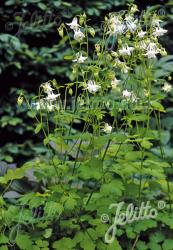
Applauded as the best golden-leafed Aquilegia, this resplendent perennial affords fine textured mounds of lucent yellow foliage in spring that soften to light green by summer. Though ‘Mellow Yellow’s head-turning visage is its signature, the charming creamy-white blooms further heighten the foliar fanfare, especially when planted near contrasting leaves like Asarum caudatum f. album and Ajuga ‘Black Scallop’.
Blooms May–July
Size: 2' 0" – 3' 0" high x 15" – 18" wide.
Hardy to zone 3.
Aquilegia vulgaris ‘William Guiness’ (P-1098)
Each $11.25
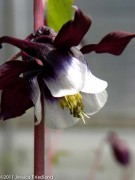
‘William Guiness’s dark purple blossoms skirt snow-white corollas, lending dramatic contrast and an element of surprise. Deeply incurved spurs stand sentinel over each nodding bloom, which rises 2 ft. on lean steady stems from a leafy bluish green mound. Set this dark knight near the gilt foliage of Campanula ‘Dickson’s Gold’ for a captivating union.
Blooms May–June
Size: 2' 0" high x 15" wide.
Zone 3/4.
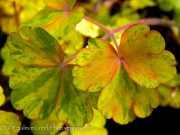
We grew this unusual cultivar from seed, and its intensely golden springtime foliage gradually transmutes into light yellow summer garb, imparting a bright glow to darker garden corners. Gorgeous bicolored blue and rose blooms heighten the display while the deep greens of Pulmonaria ‘Benediction’ and Omphalodes ‘Joy Skies’ furnish an invigorating contrast.
Blooms April–May.
Size: 18" – 2' 0" high x 12" – 15" wide.
Hardy to zone 4.
Aralia cordata ‘Sun King’ (P-1873)
Each $13.00

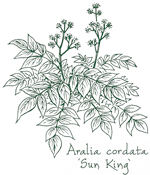
Bold, brilliant and tropical-style, this phenomenal newly introduced cultivar was first spotted by Barry Yinger in a Japanese nursery. Large, compound golden-yellow leaves grow up to 3 ft. long on energetic reddish brown stems, quickly framing a rounded bushy clump that turns lime-green when there’s too much shade. Topped with 2 ft. tall spikes of honeybee-friendly small white flowers, ‘Sun King’ promises statuesque beauty wherever it’s planted, bewitches birds with its purplish black berries and enjoys moist well-draining sites.
Blooms July–September
Size: 4' 0" – 6' 0" high x 3' 0" wide.
Hardy to zone 4.
Gracing the shade garden with a quiet textural beauty, this slowly colonizing North American perennial inhabits wooded areas, from New Brunswick to North Carolina and west to Utah and New Mexico.
Large, stout aromatic rhizomes sprout a multitude of abundantly branched glabrous stems and shrubby dark green compound foliage. The lush heart-shaped leaflets are toothed and unfurl in bronzy shades. Numerous round airy starbursts, defined by tiny cream-colored flowers, light up long terminal panicles like 4th of July sparklers. Glistening dark purple berries add additional appeal, while the spicy roots flavor root beer and yield medicinal remedies for broken bones, inflammation and asthma.
Surprisingly adaptable and easily maintained, Life-of-Man relishes bright shade, average moisture and fertile locales.
Blooms August–September.
Size: 3' 0" – 5' 0" high x 3' 0" – 5' 0" wide.
Hardy to zone 3.
Arisaema
Cobra Lily or Jack-in-the-Pulpit
These exotic-looking Calla relations comprise a vast genus primarily found in the Himalayas, China and Japan. While the sparsely produced leaves are carved into 3 or more leaflets, the curious inflorescence features a fleshy club-like spike that’s packed with tiny flowers and encompassed by an over arching flower bract. Fertile, humus-rich and evenly moist soil helps keep the Cobra Lilies charmed.
Arisaema candidissimum (P-1829)
OUT OF PRODUCTION AT THIS TIME
Email me when this plant is available
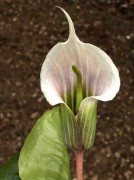
Lustrous arrow-shaped leaves, which often grow 2 ft. wide, wait ‘til early summer to burst forth with dramatic tropical appeal. Affixed to sturdy 15 in. stalks, sensational hooded flowers, resembling pink pitchers, are enhanced by striking stripes of translucent milky white vertical veins. Undemanding, deer resistant and more sun-tolerant than other Arisaema, this lusted-after Cobra Lily pledges a glorious colony, produces offsets freely and launches bold bright orange-red seed pods in late summer.
Blooms June–July.
Size: 15" – 18" high x 10" wide.
Hardy to zone 6.
Arisaema consanguineum (P-1608)
OUT OF PRODUCTION AT THIS TIME
Email me when this plant is available
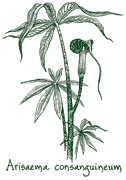
Jewel of the woodland garden, this elegant, easy-to-grow species is found throughout southwestern China. A whorl of numerous narrow leaflets with slender drip-tips and undulating edges crowns each tall stately stem. Conjuring mysterious images of a cobra poised to strike, the otherworldly inflorescence is borne from a petiole beneath the foliage. It is defined by a purplish brown and greenish white-streaked spathe with an elongated hood that tapers to a pendulous, very long, threadlike tip. Clustered, bright scarlet berries create a colorful grand finale. Fertile, humus-rich and evenly moist soil will keep the Cobra Lily charmed.
This plant will be shipped from fall through mid-spring. Most of the plants will be shipped dormant and bare-root unless we have potted ones which have sprouted.
Dormant Arisaemas in containers must not be kept wet. Water them in their pots only when the soil gets bone dry—about twice a month.
Blooms June.
Size: 3' 0" – 4' 0" high x 12" wide.
Hardy to zone 6.
Armeria
Sea Thrift
Armeria ‘Victor Reiter’ (P-1728)
Each $10.25
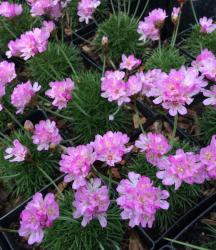
A plethora of pretty pink pom poms garnish short neddlelike green leaves, which sculpt a tidy tigthtset mound. Bobbing on tough, wiry leafless stems well above the grassy evergreen cushions, dense flower heads are described by minute spiky blooms and papery bracts.
This cute little European gem maintains a well-groomed guise in spite of seaside conditions and poor soil. It appreciates free drainage, benefits from deadheading and makes an undemanding addition to small scale plantings, the rockery or a pot.
Blooms May–June.
Size: 6" high x 8" wide.
Hardy to zone 6.
Artemisia
This plant has been used to ward off lightning, revive the weary traveler, repel moths and for deworming—hence, Wormwood. We prefer to think of the Greek goddess Artemis who, it is said, was so pleased to discover its many practical applications that she named it after herself. An annual trim guarantees a neat appearance, otherwise Artemisias are simple to grow and virtually pest free.
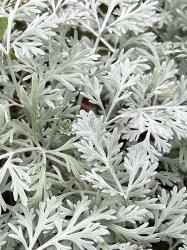
Providing welcome contrast to the garden’s leafy green palette, this incandescent Huntington Botanical Garden introduction yields a soft textured billowing dome of deeply dissected silver-gray foliage on wellbranched upright stems. Similar to ‘Powis Castle’, save for larger less sculpted leaves, ‘Huntington Gardens’ is a refined woody perennial, clad in delicate silky hairs, that can be ensconced near the middle or back of the border, where it juxtaposes broad leaves, sword-shaped blades or fiery colored flowers to great effect. It produces somewhat inconspicuous grayish yellow leafy flower heads and relishes lean, fast draining dry soil.
Blooms July–August.
Size: 3' 0" – 4' 0" high x 3' 0" – 4' 0" wide.
Zone 6/7.
Artemisia lactiflora ‘Guizhou’ (P-0180)
Each $11.25

Elevated by vigorous straight mahogany stalks that reach 4 ft. in the first season plus dapper coarsely-cut forest-green leaves, copious tiny white flowers embellish large branched panicles. ‘Guizhou’ can be paired with other tall perennials such as Aster ‘Bluebird’, or situated near Panicum virgatum ‘Warrior’ to echo its reddish stems.
Blooms August–September
Size: 5' 0" high x 2' 0" wide.
Hardy to zone 4.
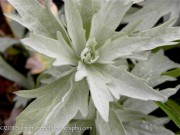
‘Valerie Finnis’ dons silvery white leaves so soft and showy you’d think they were felt. Lobed near the tips, the wide aromatic foliage lines stout, generally erect gray stems, forming a compact, noninvasive clump that makes a luminous counterpoint to lush greens or bronzes.
This prized perfect-for-drying Mugwort can be pinched to maintain its textural form and lightly sheared when dense yellowish gray flower panicles appear. Thwarting deer and tolerant of both poor or dry soil, the Western Mugwort demands excellent drainage and mopes in high humidity.
Blooms August.
Size: 15" – 18" high x 2' 0" wide.
Hardy to zone 4.
Plentiful small round buds and fluffy, pastel pink blooms populate gracefully tapered sheaves, and set against the deep purple branching stems they seem to sparkle. The elegant, airy flowers reign over an impressive textural foil of jagged-edged dark green leaves.
Blooms August – September.
Size: 5' 0" high x 18" – 2' 0" wide.
Hardy to zone 5.
Artemisia versicolor ‘Sea Foam’ (P-1507)
Each $11.25
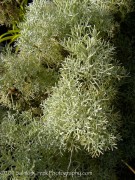
Brimming with texture, ‘Sea Foam’ hosts a frothy display of incandescent silver-gray foliage. Swirling, curly, filigreed leaves are draped like finely cut lace along vigorous firm woody stems. Not intrusive and tight-set, this low mounding shrubby perennial can take it hot but not humid, needs well drained soil, makes a good winter statement and occasionally yields cute, little yellow buttons on downy white flower spikes.
Blooms August.
Size: 8" – 12" high x 2' 0" wide.
Zone 4/5.
Aruncus
Goat's Beard
When you think of the fringes of a wooded area, think Aruncus. With delicate ivory plumes that make sterling cut flowers, Goat’s Beard is similar to Astilbe, although its sprightly form is more open. A natural beside a pool or stream, this trouble-free perennial favors moist soil, but can handle drier situations and some wind.
Aruncus aethusifolius (P-0995)
Each $10.25

Topped by creamy white plumes of minute star-like flowers, fine ultra-chiseled foliage and red-tinged stems shape a tidy dwarf habit that works well as a ground cover around flat stones and rocks. This small gem can also be tucked into the front of the border with broad-leafed Epimediums nearby.
Blooms late May–mid-June
Size: 8" high x 12" wide.
Hardy to zone 5.
Each $12.00

This spectacular North American perennial has a lot to toot its horn about: AGM recipient, bold bushy foundation and cut-flower-perfect feather-like plumes. A bee, butterfly and songbird haven, small starry cream-colored blooms populate arching, 12 in. tall, branched pyramidal panicles elegantly rising high above the long tripinnately compound green fronds, which emphasize pleated lanceolate leaflets, pointed tips and twice-serrated margins. Peerless as an easy-care stand-alone in naturalized plantings, Bride′s Feathers′s handsome upright clump shuns bunnies and deer plus appreciates evenly moist, organic-rich soil. Headline under tall trees, along partly shady streams or ponds and woodland peripheries with Asarum caudatum, Dicentra and Iris nearby.
Blooms May–June
Size: 4' 0" – 6' 0" high x 2-1/2' – 4-1/2' wide.
Zone 3b.
Aruncus dioicus ‘Kneiffii’ (P-1919)
Each $12.50

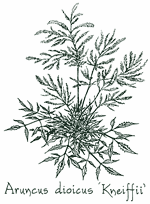
While the species is a larger perennial hailing from Missouri, this compact, daintier 1889 version sprouts Japanese Maple-shaped leaves, finely hewn with thread-like segments. Sheer cream-colored plumes of minute starry blooms twinkle above the ultrafine deep green hummock. Ideal for gardens short on space plus fresh or dry arrangements, ‘Kneiffii’ can be massed along streams or ponds and in moist shady borders or woodland gardens.
Blooms June–July
Size: 2-1/2' – 3' 0" high x 2' 0" wide.
Zone 3/4.
Aruncus dioicus ‘Zweiweltenkind’ (P-0021)
Each $10.75
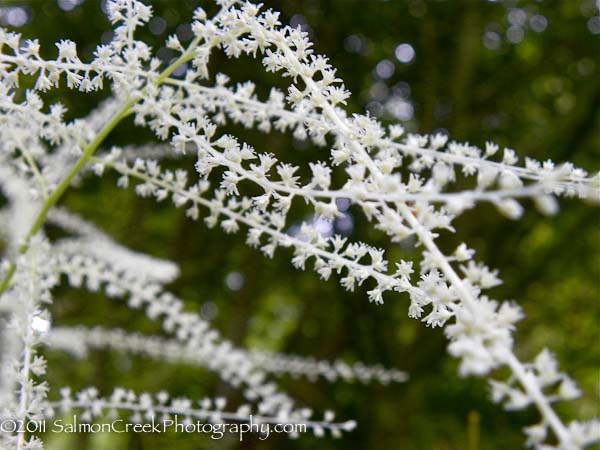
A flurry of large lacy white panicles illuminates the handsome feathered foliage and numerous branching stems. Forging a verdant leafy clump that is shorter and sturdier than the species, this German hybrid dispels all images of a stocky work plant. Its name means “child of two worlds,” and it is indeed otherworldly under tall canopies of Styrax or Maples.
Blooms June–July
Size: 2-1/2' high x 2' 0" wide.
Hardy to zone 5.
Aruncus x ‘Guinea-Fowl’ (P-2079)
Each $12.50
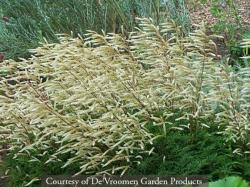
Bred by famed German plantsman Ernest Pagels, this low-growing floriferous cultivar is a cross between the European species Aruncus dioicus and the dwarf Korean native, Aruncus aethusifolius. Crinkled finely cut pinnate greenery cloaks an attractive compact mound, which once established, propels as many as one hundred 12 to 18 in. tall, arching flower stems, plus manages to maintain a trim appearance throughout the season. Staged in a horizontal fashion, petite creamy-white blooms festoon the copious, closely packed short wands, thought by some to resemble feathers, hence the curious namesake.
Blooms June–July
Size: 18" – 2' 0" high x 18" – 2' 0" wide.
Hardy to zone 5.
Each $12.50
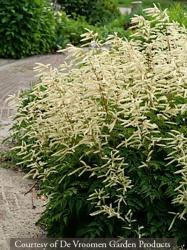
Brimming with finery, yet remarkably steadfast, this choice perennial was bred by noted German nurseryman, Ernest Pagels. ‘Horatio’ is a meticulously crafted cross between Aruncus aethusifolius and Aruncus dioicus, praised for its unique sparkling spikes of tiny cream-colored blooms, which splay out in a horizontal fashion from upright bronze-tinted stems. Fresh green fern-like foliage forms a bushy base beneath the airy star-shaped flowers.
Blooms June–July
Size: 3' 0" – 3-1/2' high x 2-1/2' wide.
Hardy to zone 4.
Each $11.25
Hailing from the Iberian Peninsula, this carefree perennial sprouts vigorous procumbent stems clad in scalloped, nearly heart-shaped gray-green leaves. The alluring downy-soft foundation gives way to enchanting pale yellow snapdragon-like flowers with deeper yellow throats, fine purple veins and a delightful sweet scent. Appreciative of cool summer locales, partial shade and a sandy loam, Asarina procumbens can scramble over rocks, trail down a wall or spill over a container. Moderately-moist well-drained crannies keep its pastel blooms unfurling all summer long.
Blooms May–September
Size: 2" – 4" high x 12" – 2' 0" wide.
Hardy to zone 6.
Asarum
Wild Ginger
Stretching out by underground rhizomes, the Wild Gingers are handsome woodland dwellers whose large-leafed, low growing colonies flourish in moist, shady niches. Long petioles elevate their polished, usually heart-shaped foliage while darkly colored, three-lobed blooms add intrigue.
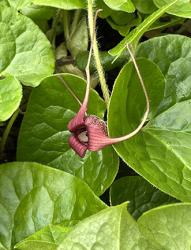
Sojourning in the dark wooded areas of western North America from California to British Columbia and Montana, this lustrous semievergreen perennial presents bold heart-shaped bright green leaves that smell like ginger when they’re crushed. Wide-spreading rhizomes sprout a low somewhat open patch, augmented by long slender petioles, silky new growth and intriguing triangular rusty-brown blooms. Ideal as an understory ground cover, Wild Ginger resists slugs and deer, enjoys loose organic soil, adapts to moist or dry conditions, and makes a verdant companion for Polygonatum ‘Variegatum’, Anemone ‘Snow Angel’ and Dryopteris ‘Brilliance’.
Blooms April–June
Size: 6" high x 18" wide.
Hardy to zone 7.
Asarum caudatum f. album (P-1548)
Each $13.50
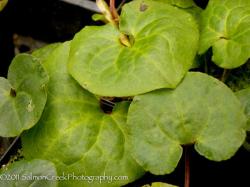
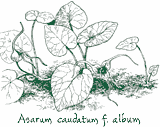
A lover of loose leafy soil, this native of western North America grows in the deep shade of redwood forests and pine woods, spreading its rhizomes to form wide patches of foliage. The 3 petals of the earthy wine-colored flowers end in long tapering wisps under deeply embossed, heart-shaped leaves. Combined with Beesia deltophylla, which is equally shade-loving, the red colors are even more enchanting.
Blooms April–June.
Size: 4" – 6" high x 0" & spreading wide.
Hardy to zone 7.
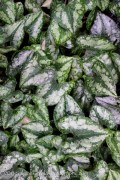
“Splendid” seems like too modest a word to proclaim the elegance of this gingers foliage! Glistening, broadly arrow-shaped, deep green leaves flaunt dramatic silver marbling and come spring, 2 in. wide dark purple blossoms with white throats. Situated among Podophyllum hexandrum, easy-to-grow Asarum splendens sculpts a show stealing, illustriously patterned ground cover in just a few years that appreciates warm, humid summers while resenting cool ones.
Blooms April–May
Size: 8" high x 0" & spreading wide.
Hardy to zone 6.
Asclepias
Milkweed, Butterfly Weed
A big-time butterfly attraction, particularly for the Monarch at larval stage, this American-born perennial promises an irresistible, long-lasting summertime display in a well-drained mixed border or more informal venue. The Milkweed's showy flowers look exceptional in cut arrangements, either fresh or dried, while its seed pods lend decorative accents.
This popular, flower-laden butterfly destination hosts large, compact rosy-pink umbels packed with petite white blooms set in dark red bracts. Sprouting from a sizable taproot, the late-to-emerge noninvasive clump of numerous, erect branching stems and narrow green leaves celebrate vibrant-looking, vanilla-scented blooms. Selected from the wild species that inhabits Missouri’s swamps and wet meadows, easily grown ‘Cinderella’ thrives surprisingly well in drier sites and can escort Baptisia ‘Solar Flare’ or ornamental grasses like Andropogon or Panicum.
Blooms July–August
Size: 3' 0" – 4' 0" high x 18" – 2' 0" wide.
Hardy to zone 3.
Asclepias incarnata ‘Ice Ballet’ (P-0565)
Each $10.75
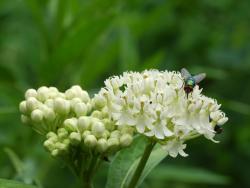
A floriferous white-blooming selection of Missouri’s native Swamp Milkweed, ‘Ice Ballet’s straight sturdy stems lift tightknit, delicately fragrant pearlescent umbels and silky haired seeds. Slender, lance-shaped deep green leaves cloak the attractive compact habit, which can be added to butterfly gardens, sunny borders or streamsides, where it lures hummingbirds as well as butterflies, especially Gray Hairstreaks and Queens. This easy-care cultivar tolerates clay, deer and wet soil.
Blooms July–August
Size: 3' 0" – 4' 0" high x 18" – 2' 0" wide.
Hardy to zone 3.
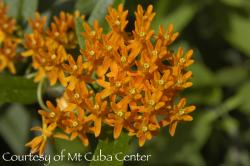
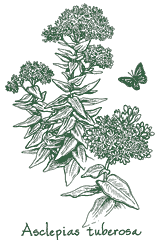
One of the most garden-worthy of all the Milkweeds, this brilliant orange flowered butterfly and hummingbird mecca can be found roaming many eastern and southern North American roadsides, prairies, glades and fields. Tuberous roots, narrow lance-shaped green leaves and clumping, upright hairy stems support the showy flattened dense umbels and unique, slim, satiny tailed seed pods. A recent recipient of the 2017 PPA as well as a rugged, yet long-blooming contender for borders, massed plantings or stylized meadows, Butterfly Weed can handle deer, drought, erosion and shallow rocky soil, but detests poorly drained sites.
Blooms July–September
Size: 2' 0" – 3' 0" high x 15" wide.
Hardy to zone 4.
Each $11.00
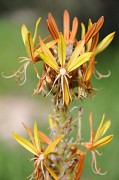
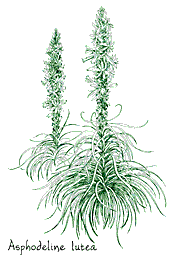
Native to the eastern Mediterranean, this clumping member of the Lily family greets spring with intriguing spirals of tightly wrapped bladelike foliage, patterned like green candy canes. Emerging from blue-hued grassy tufts, these leafy flowering spikes soon become dense with fragrant citron-yellow, star-shaped blooms, which look striking in drifts beside Omphalodes ‘Cherry Ingram’ and Euphorbia ‘Jade Dragon’. Zoë was the first to discover the hard, marble-sized, green fruit that appears after the flowers fade.
Blooms April–June.
Size: 2-1/2' – 3' 0" high x 2' 0" wide.
Hardy to zone 6.
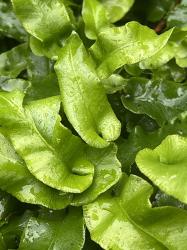
Noteworthy for its fantastic tropical-style habit, this evergreen AGM recipient sports dense, lustrous bright green rosettes of upright, arching strap-shaped fronds with wavy, undivided margins. Hart’s Tongue Fern can grace borders, cottage gardens, urban courtyards or shrub understory plantings and woodland venues, asserting a bold verdurous aspect year round. Especially effective when featured amongst fine-hewn shade lovers such as Dicentra ‘Gold Heart’ and Aruncus aethusifolius, Asplenium appreciates superb drainage, adequate moisture and dappled light, while extra humus and limestone-rich soil sustain its pest-free good looks.
Size: 12" – 18" high x 12" – 18" wide.
Hardy to zone 5.
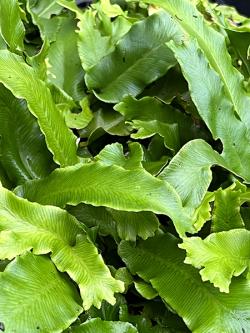
Selected from a European Asplenium form during the Victorian era, this lustrous evergreen fern develops dense vase-shaped rosettes distinguished by 1 in. wide, wavy-edged bright green fronds. Each fantastic thick “tongue” either splays, arches or twists, flaunting a rounded and ruffled petticoat-like flourish at its apex. Appreciative of light shade and moist, well-drained lime-rich soil, ‘Cristatum’s verdurous medium-sized habit lends bold glistening texture to walls and rock gardens, or woodland peripheries and mixed borders, especially when combined with generous sweeps of finer-hewn shade-loving perennials.
Size: 10" – 18" high x 12" – 18" wide.
Hardy to zone 5.
Astelia chathamica ‘Silver Spear’ (P-0718)
Each $13.00
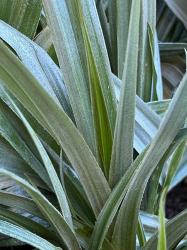
Silvery and swordlike, the stiff foliage grows in clumps and bears some resemblance to a Yucca. Highlighted with subtle bands in many shades of muted green and silver, the broad reflective leaves will make a dramatic presentation in your favorite container, or try planting Astelia as a specimen with Muhlenbergia rigens and Salvia melissodora in the rockery. Hailing from New Zealand, this unusual member of the Lily family prefers well drained soil.
Size: 3' 0" high x 3' 0" wide.
Hardy to zone 8.
Astelia nivicola ‘Red Gem’ (P-1641)
Each $13.00

Superimposed with the silky luster of abundant soft white hairs, the elegant sword-shaped foliage dons irregular, bronzed maroon stripes on an olive green background and luminous silver hues on smooth flipsides. Channeled, foot long basal leaves forge a stiffly arching evergreen tussock, arising from short thick rhizomes.
Introduced by Duncan & Davies Nursery, this dramatic New Zealand Lily relative makes an unparalleled container candidate that fancies well-drained acid soil and part shade in hot climates.
Size: 3' 0" high x 3' 0" wide.
Hardy to zone 8.
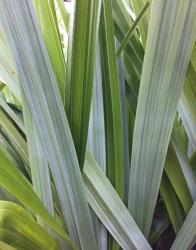
Bold, metallic and architectural, this stunning new Astelia chathamica and Astelia nervosa cross was masterminded by Tim and Hamish Prebble. The arching evergreen clump hosts strap-like, silver-frosted gray-green leaves that develop pointed tips plus lustrous pewter overlays on both surfaces. Guaranteed to be a flashy show-stealer, ‘Silver Shadow’ can be lodged in containers or mixed borders with perennials like Salvia nemorosa ‘Wesuwe’, Eryngium ‘Big Blue’ and Perovskia ‘Blue Steel’. Adequate moisture and good drainage as well as shelter from scorching sun and temperatures below 25° ensure its success. (pp#22,195)
Size: 2' 0" – 3' 0" high x 3' 0" – 4' 0" wide.
Hardy to zone 8.
Aster
Michaelmas Daisies
We never tire of Aster’s cheerful daisy faces and the profusion of colors and sizes that make up this genus, from 6 ft. giants to tiny dwarf alpines. Our Asters, large and small, are tried and true performers in ordinary garden soil and full sun. Generally late summer bloomers, they provide lots of oomph when many perennials have petered out.
Each $11.50

With a not-too-tall, high-spirited presentation of lavender-blue daisies, this compact, rarely offered Aster should find its way into more gardens.
Sturdy, wine-tinged, open branched stems maintain a pert straight-up stance carrying the big buds and two in. wide, thin rayed flowers. Rising above unusual, large green leaves distinguished by toothed margins, prominent veins and a somewhat fuzzy surface, the long blooming, sunny-eyed blossoms make a vivacious match for the darkly beautiful Sedum ‘Purple Emperor’ above our stone wall.
Blooms late July–October.
Size: 15" high x 15" wide.
Hardy to zone 5.
Blooming long after other flowers have faded, Asters are associated with afterthought and cheerfulness in old age. This Ed Carman selection is one of the largest Asters we offer, with clean-looking foliage right to the ground on strong, upright stems culminating in sprays of blue-violet flowers. Bring cheer to the fading days of summer by planting ‘Bill’s Big Blue’ with Helianthus and other stately late bloomers.
Blooms late September?early November
Size: 4' 0" – 5' 0" high x 3' 0" wide.
Hardy to zone 4.
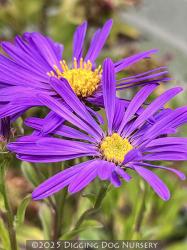
Loved by butterflies, hummingbirds and garden enthusiasts, this marvelous Aster arose from Herbert Oudshoorn′s Dutch-based breeding program. Attractive smooth dark greenery cloaks the bushy mildew-resistant clump whose upright steady stems present vivid, many-rayed violet-blue flowers with saffron-colored eyes. A floriferous choice for borders, bouquets and prairie plantings, ‘Blue Autumn’ tackles deer, bunnies, most diseases and a range of soil types, while judicious pruning ensures its long-lasting, compact good looks. (pp#17,400)
Blooms August–October
Size: 18" – 2' 0" high x 18" – 2' 0" wide.
Hardy to zone 4.
Each $11.50
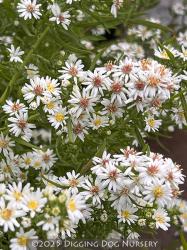
Kudos to Dr. Jim Ault at the Chicago Botanic Garden for this recently introduced distinctive Aster ‘Snow Flurry’ descendant. Fine textured close-knit branches with small, linear green leaves grow upward, then somewhat horizontally before assuming a unique weeping aspect during the summer, which is heightened by a phenomenal bounty of ½ in. wide pure white flowers. The long-lasting floral train nearly veils the entire plant and lays claim to its name, while ‘Bridal Veil’s stoic habit braves drought, salt spray and mildew. (pp#23,966)
Blooms mid-September–early October
Size: 2' 0" high x 4-1/2' wide.
Hardy to zone 5.
Each $11.50
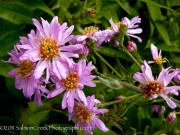
Pretty pink 1-½ in. flowers gather in festive clusters as they top sturdy stems clad in toothed linear foliage. Several layers of frilly petals swirl around the bright yellow eyes, delivering spirited color to the front lines of a perennial border, while Gaura ‘Pink Cloud’ and the darkly red Angelica gigas take up the rear.
Blooms August–early October.
Size: 18" – 2' 0" high x 2' 0" wide.
Hardy to zone 4.
Aster ‘Coombe Fishacre’ (P-0392)
Each $11.50
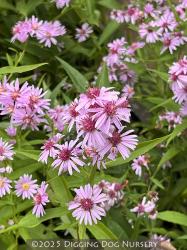
With a billowy visage, a reliable flowery nature and fine foliage that looks dapper all season long, ‘Coombe Fishacre’ is one of our favorite Asters. Its deep green leaves cover sweeping branches all the way down, while a slew of lilac flowers warmed by rosy-brown centers roost above. Well after the blooms have faded, the seed heads add intriguing colors and shapes. This first-class Aster never needs staking and can be planted in large drifts amid Miscanthus ‘Nippon’, Molinia ‘Bergfreund’ or Eupatorium ‘Gateway’ for glowing pink echoes.
Blooms August–September
Size: 2-1/2' high x 2' 0" wide.
Hardy to zone 5.
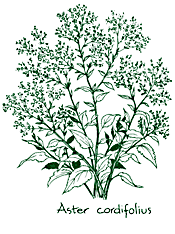
FTD should get to know this perky, rarely seen Aster, and so should you. Buds form early and fool us into thinking they’re about to bloom, but they wait until the plant reaches full height. When it does, a mass of blue-violet on erect, wiry, wine red stems leaves us breathless. Try planting Teucrium f. ‘Azureum’ in front and Molinia ‘Windspiel’ as a backdrop. When flowering ends, we find the stems and seed heads of Aster cordifolius so delightful, we leave them on for winter interest.
Blooms August–early October.
Size: 4' 0" – 5' 0" high x 2' 0" wide.
Hardy to zone 4.
Aster cordifolius ‘Avondale’ (P-1746)
Each $11.50
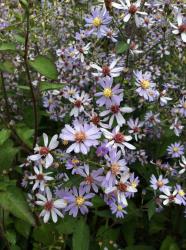
Indigenous to the southern reaches of the Appalachian Mountains, this hearty selection greets fall with a jovial long-lasting barrage of small, yellow-eyed pale lavender-blue daisies atop tidy slender green foliage. Acquiescent to varied light, it exhibits an upright open habit in sunny spots and becomes more relaxed and arching in darker recesses. Ignored by deer, but coveted by butterflies, floral arrangers and gardeners, floriferous ‘Avondale’ endures dry shade once established, favors well-drained soil and can be planted en masse along woodland fringes, meandering amid Geranium ‘White Ness’.
Blooms mid-August–early October
Size: 20" – 2-1/2' high x 18" – 2' 0" wide.
Zone 3/4.
Aster cordifolius ‘Chieftain’ (P-1609)
Each $11.50
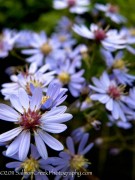
Lifted on tall strong stems, a starry haze of umpteen, tiny, pale lavender-blue daisies lining branched upright sprays earned this impressive celebrity an AGM award and a place in our garden. Rich green tailored foliage stays fresh, while the sunny-eyed flowers lend an ethereal look to the fall landscape that can be juxtaposed against the coarser beauty of Vernonia crinita. Let shrubby roses or more sturdy perennials provide support in the back of the border, otherwise it will need staking or a spring pinching to ensure a shorter stature.
Blooms mid-August – October.
Size: 5' 0" high x 3' 0" wide.
Hardy to zone 4.
Aster cordifolius ‘Little Carlow’ (P-0255)
Each $11.50
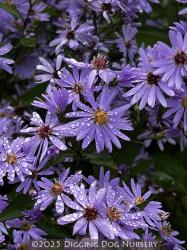
‘Little Carlow’ is lush and chipper. Its flowers are larger and a deeper violet-blue than those of Aster cordifolius, and they have bright yellow centers. The green leaves, which reach to the ground, are also broader and darker. It blends well with tall grasses like Calamagrostis and Panicums and contrasts with gold-flowering plants such as Achillea ‘Marmalade’.
Blooms mid-August–early October
Size: 3' 0" – 4' 0" high x 2' 0" wide.
Hardy to zone 4.
Each $11.50

Small white flowers like finely cut daisies, with a yellow center, and elongated heart-shaped, coarsely toothed, dark green leaves, are displayed in large clusters on sinuous, purple-black stems. This Aster is better-known in Europe, where it’s used to light up shady urban gardens. We find it indispensable in the country too, for its tolerance of dry, shady sites. A good plant for the front of the border, try it with Hypericum kouytchense or broad-leafed perennials.
Blooms mid-July–September.
Size: 15" – 18" high x 2' 0" wide.
Hardy to zone 4.
Aster divaricatus ‘Beth Chatto’ (P-2025)
Each $11.50
The sparkling sprays of tiny white daisies with pink-blushed petals plus gilt cocoa-colored centers tarry above sleek, thin, divaricated eggplant-black stems plus stylish, slightly cordate, toothed green leaves. Sprouting from slow-spreading rhizomes, this unique late-blooming Aster is more compact than the species and offers an exquisite delicacy, which the famed Gertrude Jekyll loved to showcase amid Bergenias. ‘Beth Chatto’ prospers in adequately moist shady alcoves, tolerates dry conditions once established and makes a fine-textured addition to bouquets.
Blooms mid-July–September
Size: 18" high x 18" wide.
Hardy to zone 4.
Our anticipation soars as we wait for round buds to finally unfurl a galaxy of small starry blooms twinkling in rose-tinged lilac shades. Beneath the profuse late season display, tiny green leaves stay fresh for months, garnishing stiff branching stems, which angle out and form a well-mannered mound. Illuminated by citron-yellow centers with red streaks, the dainty daisies easily gratify companions like Achillea ‘Hella Glashoff’ or Origanum ‘Bristol Cross’.
Blooms mid-August–September.
Size: 2' 0" high x 18" wide.
Hardy to zone 5.
Aster ericoides ‘Golden Spray’ (P-1610)
OUT OF PRODUCTION AT THIS TIME
Email me when this plant is available
Mirroring autumn’s warmth, this Aster’s unexpected golden floral hues bring a glittery Midas touch to the late season border. Arching branched sprays of copious small daisies with narrow buff white petals and prominent rich yellow centers rise above the well-groomed, dense leafy clump, which makes a congenial neighbor for Astrantias and Pennisetum spathiolatum.
Blooms September – October.
Size: 2-1/2' – 3' 0" high x 2' 0" wide.
Zone 3/4.
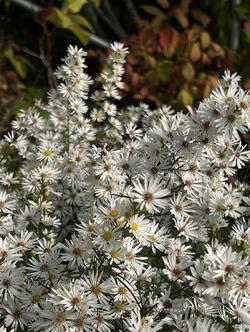
Beloved by late season garden aficionados, florists and butterflies, this exceptional Aster spotlights wispy crisp white clouds of petite yellow-centered daisies hovering above tiny tailored green leaves that form a vigorous shapely clump. ‘Monte Cassino’s delicate illuminated texture becomes a simple-to-place ethereal filler, perfect to juxtapose with bolder perennials such as Persicaria or Crocosmia.
Blooms late August–September
Size: 2' 0" – 3' 0" high x 2' 0" – 3' 0" wide.
Hardy to zone 5.
Aster ericoides ‘Snow Flurry’ (P-2124)
Each $11.50
Boasting both an AGM and a 5-star rating from the Chicago Botanical Garden, this attractive long-lived Heath look-alike was introduced to the United Kingdom by famed English garden designer and author Beth Chatto in 1983. The dense, spreading habit hosts robust, low arching stems with small, stiff, linear gray-green leaves amid a spectacular blizzard of copious petite yellow-eyed white blooms. Kin to the taller North American native, ′Snow Flurry′ makes a prostrate weed-suppressing ground cover that can ramble along a border′s frontlines, sprawl over rocks or trek upon a ledge, where it nourishes late season pollinators plus heroically tackles drought, partial shade, erosion, walnut trees and clay or lean rocky soil.
Blooms September–October
Size: 6" – 8" high x 2' 0" – 3' 0" wide.
Hardy to zone 3.
Aster x frikartii ‘Monch’ (P-0025)
Each $11.50

In some gardening circles, ‘Mönch’ is acclaimed as one of the 10 best perennials. Prolific, 2 ½ in. lavender flowers bloom generously for months on end. The clear shade blends with so many others: lilac-colored Geranium renardii, Ballota pseudodictamnus and Kniphofia ‘Green Jade’.
Blooms July–October
Size: 18" high x 2' 0" wide.
Hardy to zone 5.
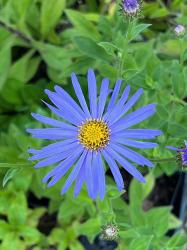
Named for a Swiss mountain, this bushy Aster ‘Mönch’ relation arose in 1924 when the savvy Swiss Aster enthusiast, Carl Ludwig Frikart crossed Aster amellus with Aster thomsonii. The compact, slightly shorter stance boasts AGM status plus long-lasting broad sprays of large slender-petaled and gilt-centered lavender-blue daisies poised above handsome oblong-shaped, mounding dark greenery. Delighting butterflies, gardeners and florists alike, ‘Wunder von Stäfa’ can be lodged amid Amsonia ‘Blue Ice’, Crocosmia ‘Solfatare’ and Rudbeckia ‘Viette’s Little Suzy’, where it braves mildew as well as periodic dry conditions, but detests winter wetness.
Blooms July–October
Size: 18" – 2' 0" high x 18" – 2' 0" wide.
Hardy to zone 5.
Aster laevis ‘Bluebird’ (P-1240)
Each $11.50
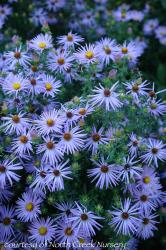
If you are looking for a Aster with engaging late season color, impeccably handsome mildew resistant foliage and a medium-sized frame that never needs staking, look no farther! Clad in glabrous, bluish green leaves, the vase-shaped clump showcases numerous broad, bouquetlike clusters of single, one inch wide, delicately rayed petals gathered by gilded centers. The jubilant floral display is elevated on red-hued stems and seems to cover the entire top half of the plant. Undeterred by varied moisture levels and soil types, ‘Bluebird’ is a Mt. Cuba Center introduction.
Blooms August–October.
Size: 4' 0" high x 2' 0" – 2-1/2' wide.
Hardy to zone 4.
Aster laevis ‘Climax’ (P-0506)
Each $11.50
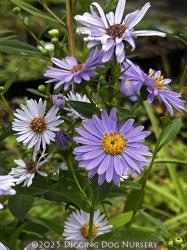
Unfurling later than most Asters, droves of spectacular soft blue-mauve flowers embroidered with yellow eyes signal autumn's arrival on beefy upright stalks. This erect strong growing perennial dons dense dark green leaves that maintain their winsome mildew-free appeal ‘till the caramel-colored seed heads begin to fade. A compelling presence for the mixed border, ‘Climax’ complements other fall bloomers such as Helianthus ‘Dakota Queen’ and Persicaria ‘Fat Domino’.
Blooms mid-September?October
Size: 2-1/2' – 5' 0" high x 2' 0" wide.
Hardy to zone 5.
Aster lateriflorus ‘Bleke Bet’ (P-1303)
Each $11.50
Purchased when we were touring British nurseries nearly 20 years ago and sadly forgotten about, this peerless Aster recently grabbed our attention. Dashing, deep purple-infused green foliage and dense well-branched twiggy stems lift an exuberant profusion of small, rose-centered white daisies, whose fine-hewn petals mature with soft pink shades. Strong, tall and upstanding, seldom offered ‘Bleke Bet’ delivers late, long-lasting flowers plus refined texture, while escorting companions such as Eryngium yuccifolium and Calamagrostis ‘Cheju-Do’.
Blooms September–October
Size: 4' 0" – 4-1/2' high x 3' 0" wide.
Hardy to zone 4.
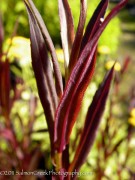
Shrouded in mysterious tiny black-purple foliage, ‘Lady in Black’ offers sprays of small white flowers with a healthy blush of pink. Unlike ‘Prince’s tight clumping habit, this Dutch lady’s elegant and tall upright stems will spread slowly over time.
Blooms September–October
Size: 3-1/2' – 4' 0" high x 3' 0" wide.
Hardy to zone 4.
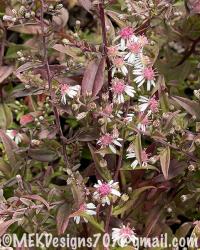
This classy fine-textured Aster is cherished as much for its myriad late season blooms as for its bushy, ebony-infused purple foundation. Stiff horizontal branches plus dashing, narrow leaves cushion the buoyant display of petite white daisies embroidered with mulberry-hued centers. A flower-laden grace note in the autumnal border, ‘Prince’ can be surrounded by loyal subjects such as Persicaria ‘Blackfield’ and Phlomis tuberosa.
Blooms September–October
Size: 2-1/2' – 3' 0" high x 2-1/2' – 3' 0" wide.
Hardy to zone 4.
Aster lateriflorus ‘White Lovely’ (P-1366)
Each $11.50
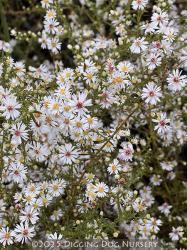
A preeminent star of the fall show, ‘White Lovely’ entertains petite, thin-petaled white daisies tinged lilac when mature and brightened by sunny-side-up yellow eyes. The copious, late summer flowers are borne along horizontally branched leafy sprays of arching and wide-angled, purple-streaked stems with small, slender dark green foliage that never tuckers out.
We like to plant Monarda ‘Violet Queen’ and Melianthus ‘Antonow’s Blue’ behind while headlining this elegant Aster right up front.
Blooms August–early October.
Size: 2-1/2' high x 2-1/2' wide.
Hardy to zone 4.
Aster macrophyllus ‘Albus’ (P-2176)
Each $11.50
A friend to bees, butterflies and flower arrangers, delightful umbels of countless yellow-centered, starry white flowers twinkle atop lean straight purple-tinted stems. Winsome heart-shaped deep green leaves forge a bushy compact ground cover-like habit that’s sustained by sturdy rhizomes. Selected from the eastern North American native, this easy-care weed-quelling perennial flourishes in light shade plus tolerates tree roots, making it the go-to choice for skirting beneath Amelanchier ‘Smokey’ or Viburnum ‘Mary Milton’.
Blooms August–October
Size: 2-1/2' – 3' 0" high x 2' 0" – 2-1/2' wide.
Zone 3/4.
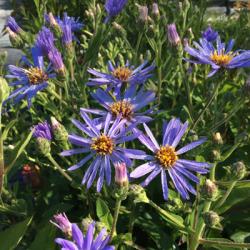
A “real winner” is how the late celebrated plantsman and author Christopher Lloyd described this form of our versatile eastern North American native Aster. Slow-spreading rhizomes plus toothed heart-shaped leaves compile an attractive green basal rosette, bearing upright red-imbued stalks and broad, openly branched flat-topped clusters of rich lavender-blue daisies with yellow centers that age to rose. Flower-laden, mildew-free and amenable, ‘Twilight’ can be massed at a woodland’s edge and be added to cottage gardens or perennial borders, where it tolerates dry shade.
Blooms August–September
Size: 2-1/2' – 3' 0" high x 18" – 2' 0" wide.
Zone 3/4.

Bred by Mr. Hilliard from Williamsburg, Iowa and celebrated by Graham Stuart Thomas for its ample “garden charm,” this well-loved Aster highlights pink flowers and a tall profile. Lavish quantities of dainty gold-centered daisies, each house nearly 50 layered finely cut rays, while cresting thick straight, somewhat woody, branched stalks. The robust grayish green clump, crowded with stem-clasping, bristle-rough, 4 to 5 in. long leaves, tolerates wet soil and some shade, resists mildew and looks lovely next to Sedum ‘Indian Chief’ and blue-blooming Asters.
Blooms August–September
Size: 3' 0" – 5' 0" high x 2' 0" – 3' 0" wide.
Hardy to zone 3.
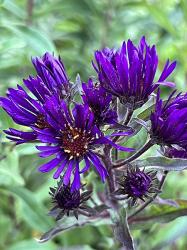
Clothed in tasteful fine-haired lanceolate greenery, a rounded bushy base of tall, upright sturdy stems supports ′Nachtauge′s striking late season floral fete. Slender lanky petals dancing around saffron and russet-hued centers plus decorative recurved calyces describe the dark-as-night purple flowers. Selected by German plantsman Till Hofmann, this mighty perennial lends regal richly-hued grace notes to fellow back-of-the-border cohorts such as Helianthus ‘Sheila’s Sunshine’ and Eupatorium ‘Riesenschirm’.
Blooms September–October
Size: 3-1/2' – 5' 0" high x 20" – 2-1/2' wide.
Hardy to zone 4.
Aster novae-angliae ‘Purple Dome’ (P-0175)
Each $11.50
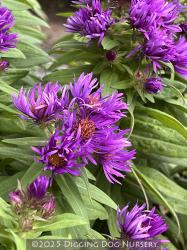
Lose yourself, like the linear, dark green fuzzy foliage, in a sea of royal purple flowers held on erect stems. Mildew resistant, compact and bushy, the handsome symmetrical mound becomes engulfed with 1-½ in. wide, golden-eyed, vividly colored daisies in a truly breathtaking spectacle, especially when planted en masse.
Dr. Richard Lighty developed this easy-care, late season show stopper that makes a sterling addition to arrangements and a captivating counterpoint to Stipa arundinacea.
Blooms August – early October.
Size: 18" high x 18" – 2' 0" wide.
Hardy to zone 3.
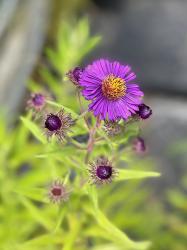
Copious clusters of fine-rayed, plush dark purple flowers with large butterscotch-colored discs are buoyed by ‘Violetta’s tall, close-knit stand of straight mighty stems. Beneath the nearly iridescent star-like blooms, dashing lance-shaped green leaves garb the vigorous, somewhat woody clump. This stately New England native resists mildew, cherishes sun, handles some shade, nourishes pollinators and birds plus splashes luxuriant late season color amid fall borders, butterfly gardens and prairie-style plantings.
Blooms August–October
Size: 4' 0" – 5' 0" high x 2' 0" – 3' 0" wide.
Zone 3/4.
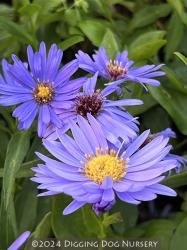
This Aster’s alluring flowers promise a late season hurrah. Supported by stiff branching stems lined with verdant linear foliage, the blooms are the size of silver dollars, and layers of their snug vibrant blue-violet petals radiate from yellow and maroon centers. ‘Blue Danube’ lends an air of elegance in the midst of Calamagrostis brachytricha and Angelica gigas.
Blooms September–early October
Size: 3' 0" high x 2' 0" wide.
Hardy to zone 5.
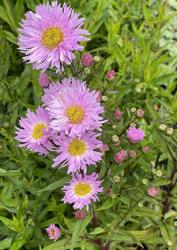
Stepped in luscious pink shades, splendid double flowers feature lime-colored eyes encompassed by layers of slim petals that later twist and curl, becoming fuller and more shapely with age. Tasteful lance-shaped dark green leaves and slender branched stems fashion an upright, bushy foundation beneath the bountiful nectar-rich blooms. A well-endowed diva for the fall garden, this robust AGM recipient can romp around Eryngium ‘Blue Glitter’ and Festuca ‘Eilers Beauty’.
Blooms late August–October
Size: 3' 0" high x 18" – 2' 0" wide.
Hardy to zone 5.
Aster novi-belgii ‘Schneekissen’ (P-2271)
Each $11.50
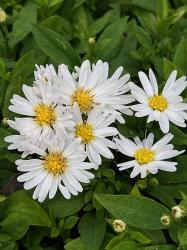
An unparalleled profusion of petite long-petalled snow-white daisies brightened by pronounced egg-yolk-colored centers is this peppy Aster′s claim-to-fame. Enticing bees, butterflies and other beneficial insects, sparkling early autumn flowers engulf upright branched stems and narrow, lance-shaped green leaves that snugly garb the dwarf cushion-like mound. Tailor-made for small well-drained gardens and other tight nooks, ′Schneekissen′s compact stance can adorn rockeries, soften pathway edges, nestle against steps and roost in containers, where it tolerates coastal sites plus dry conditions.
Blooms September–October
Size: 9" – 12" high x 9" – 12" wide.
Hardy to zone 4.
When this cultivar first bloomed in our garden, we were delighted to see such large flowers! A breathtaking contrast of pure white blossoms against handsome, verdant foliage with wine-colored veins creates a presentation even more spectacular than that of ‘Climax’. Combine with Origanum ‘Ed Carmine’ for a showy summer farewell.
Blooms September–early October
Size: 2-1/2' – 5' 0" high x 2' 0" wide.
Hardy to zone 5.
Aster oblongifolius ‘Dream of Beauty’ (P-1874)
Each $11.50
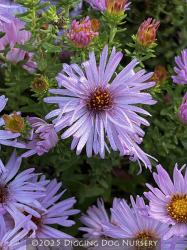
Introduced in 1960 by the legendary South Dakota-born cattle rancher and plantsman Claude Barr, this hard-working native plains Aster may be small on stature but is big on bloom. Densely-arranged low-spreading gray-green leaves weave a vigorous sturdy base that puts on a mighty fine fall showing of sweet sugary pink daisies with burnt orange centers. Withstanding drought, some afternoon shade and a wide range of soil, including clay, ‘Dream of Beauty’s remarkable floral output and tailored compact habit can be staged atop a garden wall or along a pathway.
Blooms September–October
Size: 12" high x 18" – 2' 0" wide.
Hardy to zone 4.
Aster oblongifolius ‘October Skies’ (P-1241)
Each $11.50
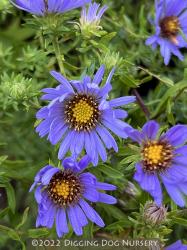
Named for the copious, fine rayed, sunny-centered daisies, mirroring the azure atmosphere of a New England fall day, this Aster was also selected for its trim short stature and easygoing, stalwart disposition. Small, narrow green leaves emit a light scent when handled and form a low, close-knit bushy mound that abides dry, rocky or sandy soil. While the species is one of the last wildflowers to bloom in the eastern U.S., ‘October Skies’s lavender-blue flowers maintain their good looks after an early frost, lend jaunty accents to bouquets and beckon the butterflies.
Blooms September–October
Size: 18" high x 18" – 2' 0" wide.
Hardy to zone 5.
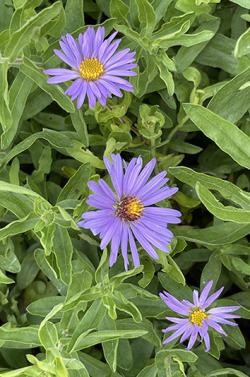
Mr. Raydon Alexander of San Antonio, Texas, said this hearty mint-scented Aster was his favorite, and we’re sure you’ll agree. Originating near Lookout Mountain, Tennessee, drought tolerant ‘Raydon’s Favorite’ quickly forges a valiant, dense mound that gets buried under multitudes of bright blue-lavender daisies. With late richly colored flowers, distinguished by sunlit yellow eyes and fine-textured single rays, and a no-fuss, orderly nature, it proves indispensable in the fall border.
Blooms September – October
Size: 3' 0" high x 2' 0" wide.
Zone 3/4.
Aster ‘Ochtendgloren’ (P-1087)
Each $11.50
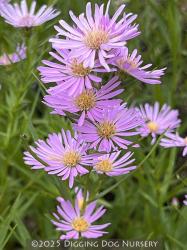
Conjuring a zestful spirit as summertime wanes, this elegant Aster parades branched heads of dainty pink starlike blooms and darker pink buds. The long and narrow, densely set foliage that lines its stiff, sturdy stems is handsome right to the ground. Claiming Aster pringlei lineage, ‘Ochtendgloren’ merrily partners with Pennisetum ‘Moudry’ and Geranium ‘Buxton’s Variety’ in front of our Beech hedge.
Blooms August–early October.
Size: 4' 0" – 5' 0" high x 2' 0" – 3' 0" wide.
Hardy to zone 4.
Meandering throughout central and southeastern North American prairies, fields, rocky slopes and woodland margins, this intrepid beauty was discovered along Ohio’s Oolentangy River in 1835 by botanist John Riddell. Low-growing, thick green basal foliage—rough-to-the-touch, long-petioled and somewhat cordate at the base—gives way to an eye-catching burst of sprightly 1 in. wide, blue-rayed and yellow-eyed daisies on firm upright branching stems that are loosely lined with smaller lanceolate upper leaves. Aptly named Sky Blue Aster conquers drought and poor soil, appreciates superb drainage and assures enduring verve in mixed borders, butterfly gardens, native plantings or cut arrangements.
Blooms September–October
Size: 2' 0" – 3' 0" high x 18" – 2' 0" wide.
Hardy to zone 3.
Each $11.50

Sharing lineage with ‘Calliope’ as well as Aster novi-belgii, this seldom-offered Aster presents a riveting display of large vibrant violet-blue flowers donning gold and reddish brown stamens. Tailored bushy foliage attires sumptuous maroon stems beneath the late season, larger-than-average blooms. Tolerant of some shade and dry periods once established, hearty ‘Orpheus’ can grace a bouquet or mosey alongside Liatris ligulistylis and Rudbeckia ‘Loofahsa Wheaten Gold’.
Blooms August– early October
Size: 4' 0" high x 18" wide.
Hardy to zone 5.
Aster pyrenaeus ‘Lutetia’ (P-0631)
OUT OF PRODUCTION AT THIS TIME
Email me when this plant is available
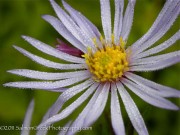
‘Lutetia’ is one of our favorite low growing Asters, and by summer’s end you’ll see why. Its pink buds open into a charming blanket of large, yellow-centered, pastel daisies with delicately splayed lavender petals, completely hiding the loose mound of finely textured foliage and intertwined, wiry, deep purple stems.
Blooms August–October
Size: 18" high x 2' 0" wide.
Hardy to zone 6.
Aster tataricus ‘Jindai’ (P-0632)
Each $11.50
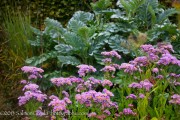
The name may sound like one of the bad guys from Star Wars, but this unique Aster is definitely on our side with its upright bearing and lush textural appeal. Not as towering as its moisture-loving Asian counterpart, ‘Jindai’ spawns huge, serrated rough-to-the-touch leafage on shorter stout stalks and abundant branched sprays of late-blooming violet flowers engraved by large saffron eyes. A stand-alone for the mixed border, its assertive look can offset finer textured plants like Spiraea ‘Ogon’ and Phlox ‘David’.
Blooms September–November
Size: 3' 0" high x 2' 0" wide.
Hardy to zone 3.
Aster tongolensis ‘Napsbury’ (P-2132)
Each $11.50
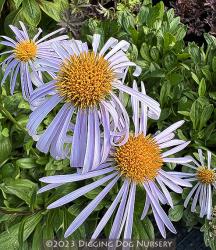
Cavorting in rocky alpine meadows from Western China to Nepal, this fetching Himalayan denizen sprouts a low, long-lived mound of hairy dark green foliage. Numerous nearly leafless, erect 18 in. stems, each lift a singular, large violet-blue flower distinguished by perky egg-yolk-colored centers and slim, spaced petals that elegantly flex downward as they mature. A delight to birds, butterflies and plant lovers, ‘Napsbury’s smaller slow-spreading stature is tailor-made for the front of the border, a rockery or well-drained cottage garden.
Blooms May–July
Size: 18" high x 2' 0" wide.
Hardy to zone 4.
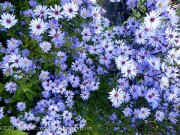
With a carefree cant, green, lance-shaped leaves have a lively look all season. Lean, dark violet-streaked stems give way to airy, lavender-colored sprays of glassine blossoms whose open petals are caught in a vivid yellow center. The red hues in the stems of Panicum ‘Shenandoah’ and Echinops enliven this Aster’s rich verdure.
Blooms September–October.
Size: 4' 0" high x 2' 0" wide.
Hardy to zone 3.
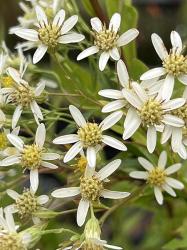
Prized for an ebullient white floral display that’s both early and long lasting above plucky green leaves and an amenable pest-free bent, this mostly eastern American native gives you good reason to usher it into your garden. The straight staunch stalks yield ovate to lanceolate-shaped leaves beneath niveous, flat-topped branching clusters of spaced, thin-rayed flowers with creamy yellow centers. Beloved by bees and butterflies, Aster umbellatus is well-suited for cottage gardens, nectaries and sunny perennial borders, favoring moist sandy sites but adapting to dry conditions as well as clay soil and some shade.
Blooms August–September
Size: 4' 0" high x 2' 0" wide.
Hardy to zone 3.
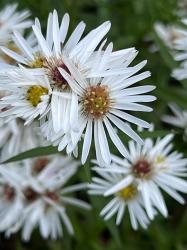
A floriferous cultivar of our native Aster, ‘White Swan’ promises dense sprays housing profuse thin-rayed white blossoms with prominent saffron-hued centers. Slender, branched upright stems and narrow, lance-shaped green leaves fashion an attractive bushy base beneath the light-hearted late season pomp that tempts bees, birds, butterflies and floral designers alike. Heightened by maroon-tinged fall foliage plus pouffy seed heads, this winsome clump-forming perennial appreciates sun, adequate moisture, good drainage, average fertility and proper air flow.
Blooms September–October
Size: 2-1/2' – 3' 0" high x 18" – 22" wide.
Hardy to zone 4.
Astilbe
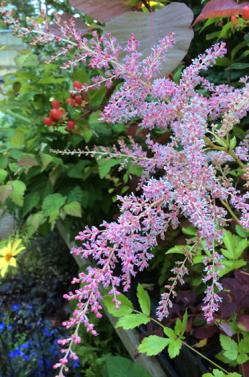
False Spiraea
Where would gardening be without Astilbes? A natural for soft-looking vertical statements, it’s distinguished by spectacular feathery plumes rising above finely cut foliage of green and bronze. Its hardiness belies its lovely delicate form. Rewarding you with oodles of cut flowers, these easily grown, unflappable perennials prefer to lounge in cool moisture-retentive soil with sun to dappled shade.
Astilbe x arendsii ‘Augustleuchten’ (P-1974)
Each $11.75
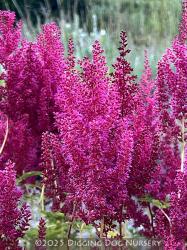
The cultivar name translates to “august light”, alluding to its magnificent feathered scarlet-red plumes that are touted as blooming later than most other arendsii. The erect fluffy flowers ascend on slender stems from a lustrous, bushy fern-like clump of young leaves imbued with rubescent shades plus mature dissected deep greenery. Another spectacular George Arends creation, this Astilbe looks best in sweeps, makes a long-lasting addition to cut arrangements and wards off rabbits as well as deer.
Blooms July–August
Size: 2-1/2' – 3' 0" high x 18" – 2' 0" wide.
Hardy to zone 4.
Astilbe chinensis ‘Finale’ (P-0507)
Each $11.75
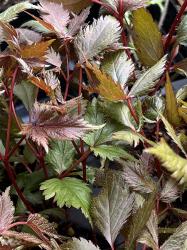
Like a grand finale of summer, soft pink, long blooming flower spikes at least a foot tall start heading skyward in late summer and keep going until autumn. Their upright appearance makes for a perfect blend with Molinia, Stachys ‘Primrose Heron’ and Geranium ‘Orion’.
Blooms August–September.
Size: 3' 0" high x 2' 0" wide.
Hardy to zone 4.
Astilbe chinensis ‘Pumila’ (P-0031)
Each $11.75
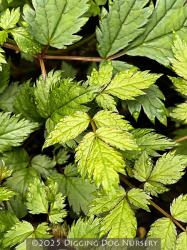
It’s a happy chance that this exquisite low growing Astilbe makes a dense, weed-proof ground cover with its glossy, deep green leaves. We plant it under the dappled light of large Hydrangeas, and by midsummer ‘Pumila’s rosy mauve flowers put on a colorful display.
Blooms mid-July–September.
Size: 12" high x 12" wide.
Hardy to zone 4.
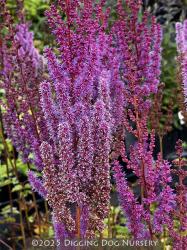
Favored for its spectacular upright architecture, ‘Purpurlanze’ sprouts handsome ternately-lobed dark green foliage crowned by straight lance-shaped purple spires, whose soft tightknit appearance begs a caress. Blooming later than most Astilbes, plus tackling more sun and drier conditions, this showy cultivar’s statuesque accents span nearly three seasons. Relish it in woodland fringes with companions like Persicaria ‘Fat Domino’, Hydrangea ‘Rocklon’ and tawny-plumed grasses.
Blooms August–September
Size: 3' 0" – 4' 0" high x 18" – 2' 0" wide.
Hardy to zone 4.
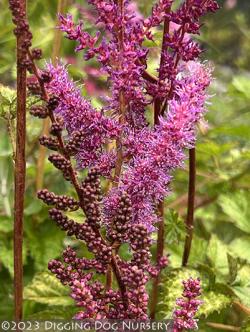
This vigorous perennial is indeed superb with urbane jagged-edged foliage, narrow dense spikes of vibrant lavender-pink blooms and a rugged stately constitution that handles more heat and drought than other Astilbes. Distinctive cut leaves emerge a mahogany red and later turn deep green beneath strong, straight-backed tall flowering stalks. One of the latest of the genus to open, the stunning blossoms precede cozy chocolate-brown dried seed heads, forging a dignified presence in the winter garden.
Blooms August–September
Size: 3' 0" – 4' 0" high x 18" – 2' 0" wide.
Hardy to zone 4.
Astilbe x crispa ‘Perkeo’ (P-1793)
Each $11.75
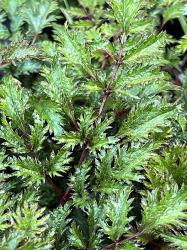
Lustrous, heavily divided crinkly foliage that sculpts an impeccable small-sized mound sets this AGM winner apart from other Astilbes. Grounded by compact, low growing dark green leaves and reddish henna-suffused young growth, short stiff upright stems unfurl attractive triangular spires of miniature deep rosy-pink flowers. Enduring drier soil in shady spots and nearly full sun in cool summer regions, ‘Perkeo’ can enrich the front lines of a border, a shady rock garden or patio container.
Blooms July–August
Size: 10" high x 10" wide.
Hardy to zone 4.
Each $11.75
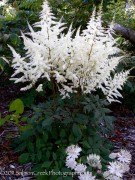

A preeminent white-flowering variety, this japonica hybrid promises to soothe your senses with its large snowy white sprays. Sharply toothed leaves gather in a shiny dark green foil for the branching pyramidal-shaped flowers whose lacy bright blooms fade to green as they wane. Like a breath of fresh air ushering in summer, ‘Ellie’s incandescent beauty can be shown off in drifts, alongside Campanula ‘Kent Belle’s violet-blue flowers.
Blooms May–June
Size: 2' 0" high x 18" wide.
Zone 3/4.
Each $11.75

Flamingo pink and proud of it, long arching, plump floral fingers extend out, gracefully cascading from the slightly fragrant, well branched upright panicles. These tapered, broad, airy towers give a long ladylike showing, while a handsome dark green clump of glistening, jagged-edged leaflets does the footwork. An esteemed Astilbe arendsii descendant, ‘Flamingo’ never needs staking, easily melds mauves and blues, and holds our interest into winter when its bushy blooms impart rich brown tones.
Zone 3/4 (pp#12664).
Blooms July – August
Size: 2-1/2' high x 18" wide.
Hardy to zone 4.
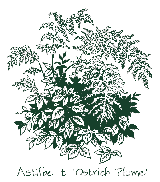
Large, open-branched fluffy plumes of petite rich coral pink flowers make a stylish weeping gesture above lush dark greenery, earning this heavy blooming thunbergii hybrid a coveted AGM and celebrated status as one of the most graceful Astilbes. Cultivated since 1952, ‘Ostrich Plume’s delicate looking blooms and vigorous fern-like mounds, which feature sharply toothed compound leaves and bronze-tinged new growth convey dreamy Impressionistic accents, especially when surrounded with Astrantia ‘White Giant’.
Blooms May–June.
Size: 3' 0" high x 18" wide.
Hardy to zone 4.
Astilbe x rosea ‘Peach Blossom’ (P-0032)
Each $11.75
This stoic beauty puts on the ritz with fern-like, prominently toothed, lustrous green leaflets and petite peach-pink flowers that snugly populate broad graceful plumes. Perfect for chic pastel-colored additions to cut arrangements, fresh or dried, the copious long-lasting blooms alight slender steadfast stems, casting cozy caramel hues in winter. Undaunted by heavy shade, most pests, black walnut trees, rabbits and deer, undemanding ‘Peach Blossom’ entices butterflies, detests drought and looks best when massed. Let its verdant compact mound rollick amongst the dappled light of perennial borders as well as cottage gardens, woodland peripheries plus pond or stream sides.
Blooms May–early July
Size: 18" – 2' 0" high x 12" – 18" wide.
Hardy to zone 4.
Though this compact low-growing Astilbe is closely related to Astilbe ‘Sprite’, its fine-textured profile is taller and its glossy lobed leaves are a lighter green. The handsome mounding foliage yields firm wiry stems with posh open plumes of petite, starry light pink flowers that produce attractive rust-colored seed heads for winter appeal. Adored by floral designers, butterflies and hummingbirds, ‘Hennie Graafland’s fluffy pastel-hued blooms and steadfast habit prefer even moisture and look best when planted in drifts, either along a pond, pathway or border’s edge, where it braves rabbits, clay soil and occasional drought.
Blooms July–August
Size: 18" high x 18" wide.
Hardy to zone 4.
Astilbe x ‘Snowdrift’ (P-1915)
Each $11.75
Living up to its name, this dazzling Alan Bloom arendsii selection spotlights feathered pristine white flowers and gleaming medium green compound leaves. The majestic, broad triangular spires top slender upright stems above tailored deeply hewn toothed leaves, imparting a classic combination of green and pearly white. Easily grown ‘Snowdrift’ can be utilized as an edging plant along paths and ponds or be massed as a spectacular ground cover.
Blooms May–June
Size: 2' 0" high x 18" wide.
Hardy to zone 4.
Each $11.75
Winner of the 1994 Perennial Plant of the Year award plus the 1993 AGM, this long-loved Alan Bloom introduction is championed for its drooping, widely spaced shell-pink panicles and urbane, lustrous dwarf habit. Parented by Astilbe simplicifolia and Astilbe glaberrima saxatiles, ‘Sprite’s arching, airy array of star-shaped flowers lingers all summer above dense, fine textured fern-like greenery with bronze hues. Later, spent blooms morph into ornamental rust-colored seed heads, lending cozy late season allure.
Blooms July–August
Size: 12" – 18" high x 12" – 18" wide.
Hardy to zone 4.
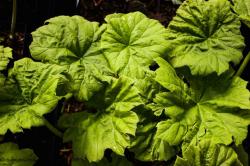
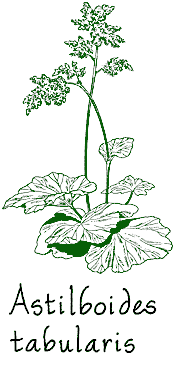
The great, broad planes of this magnificent Chinese native bring an unmatched calm to shady garden spots. Recessed in the center where thick, hairy stalks are attached, the bold foliage emerges in unique bright green shades, and later matures to light green. Nearly 2 ft. across, each slightly lobed, umbrella-like leaf is tastefully scalloped. Strong, dark-flowering stems soar aloft to 5 ft., hosting heavy pendulous plumes of star-shaped, creamy-white flowers. Once considered a member of the genus Rodgersia, this monumental Astilboides thrives in moist, humus-rich soil.
Blooms June–early August
Size: 5' 0" high x 3' 0" wide.
Hardy to zone 5.
Astrantia
Masterwort
According to Smith’s Exotic Botany of 1805, “The more refined admirers of Nature” rate Astrantia among their favorite blossoms. The flowers resemble tiny enchanting fireworks: a starburst of bracts surround the spray of small blooms and splashy groups of buds shoot out from branched stems like the finale on the 4th of July. If a natural look is what you’re after, plant Masterworts near a lightly shaded patio or path where you can enjoy their detail. This is an ideal cut flower, fresh or dried.
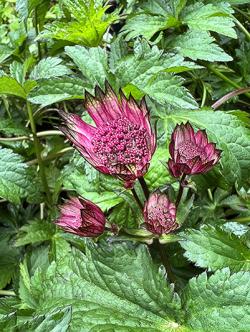
British Astrantia purveyor Gill Richardson embarked on a quest to breed a red-hued version of Astrantia ‘Shaggy’ and later introduced ‘Burgundy Manor’ as the prized outcome. Pronounced, long-lasting, crimson-tipped bracts embellish the sumptuous, petite port-colored flowers festooning domed heads. All this starry-eyed floral splendor is presented upon impressive vibrant green mounds of lithe, slightly curved stems plus attractive palmate foliage that’s long-petioled and deeply lobed.
Blooms June–August
Size: 2' 0" – 2-1/3' high x 18" – 2' 0" wide.
Hardy to zone 5.
Astrantia major ‘Buckland’ (P-1612)
Each $14.00

For its robust stature and endless supply of light-hued, good-sized blooms, this Astrantia major and Astrantia maxima hybrid earns its keep in our garden. Each pearl-green ruff houses an airy, dusky-pink pincushion that brims with intrigue and soothing shades. ‘Buckland’s nearly 6 month long floral show tempts bees, butterflies and gardeners, while cresting stout branched stems and tight-set 5-lobed, verdant toothed leaves.
Blooms mid-June–October
Size: 2' 0" high x 18" wide.
Hardy to zone 5.
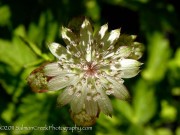
Slender yet hearty, the long erect stems host bouquets of intricate dome-like flowers tended by upturned bracts in soft pale pink shades. The large, captivating blossoms complement lush, palmately-lobed basal foliage. Named for a Dutch gardener, this vigorous Astrantia imparts a sophisticated flair to any garden setting that’s laced with light.
Blooms mid-June–September
Size: 2-1/2' high x 2-1/2' wide.
Hardy to zone 5.
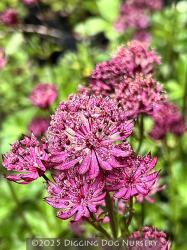
A dark drama is played out when ‘Claret’ is cast in a supporting role at the shady edge of the garden border. Dark red “pincushions” neatly cupped in bracts, and nearly black stems have an air of mystery as they rise from the luxuriant palm-shaped foliage. With long lasting flowers, ‘Claret’ is like a fine wine—something you want to always have on hand.
Blooms mid-June–September.
Size: 22" high x 15" wide.
Hardy to zone 5.
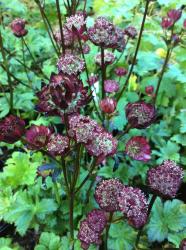
Esteemed for the glorious borders she created at Hadspen House, Nori Pope introduced this sought-after richly hued beauty. ‘Hadspen Blood’ is considered one of the darkest red cultivars, flaunting intricately detailed deep carmine flowers that shine like rubies over large, lustrous palmate leaves. Stage near Persicaria ‘Red Dragon’ and savor the lavish union.
Blooms mid June–September
Size: 2' 0" high x 18" wide.
Hardy to zone 5.
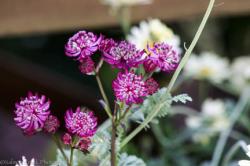
Celebrating bright and cheerful colors, crowns of maroon bracts deliver gorgeous cherry-red floral mounds with lighter pink centers. The blooms loll high above broad, deep green lobed leaves on slender stems. This energetic Danish cultivar looks a bit like an overly exuberant Italian Flat Parsley and makes an unparalleled up-front cottage-style filler that is easy to care for.
Blooms mid-June–September
Size: 2' 0" – 2-1/4' high x 18" wide.
Hardy to zone 5.
Astrantia major ‘Madeleine Van Bennekom’ (P-1875)
OUT OF PRODUCTION AT THIS TIME
Email me when this plant is available
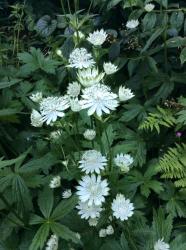
Copious, extralarge domed white umbels plus spiky niveous collars with green-tipped bracts become a study in refinement, poised on ‘Madeleine van Bennekom’s stand of sprightly branched stems and openly set deep green foliage. Ideally planted on the woodland’s fringe, this enduring well-groomed beauty imparts illuminated floral allure to neighbors such as Leycesteria ‘Golden Lanterns’ and Deschampsia flexuosa.
Blooms June–August
Size: 18" – 2' 0" high x 15" – 18" wide.
Hardy to zone 5.
Distinguished by its uniquely colored blooms and valiant upright silhouette, this spectacular new cultivar debuts large, rounded sprays of petite, purple-infused burgundy flowers resting upon showy silver and crimson-hued bracts. Shiny, toothed palmate dark greenery elevates the bountiful floral display that unfolds from spring ’til October and makes a gorgeous full-toned match for Rodgersia ‘Bronze Form’ and Geranium ‘Anne Thomson’.
Blooms June–September
Size: 2' 0" high x 18" – 2' 0" wide.
Hardy to zone 5.
Astrantia major ‘Pink Pride’ (P-1743)
OUT OF PRODUCTION AT THIS TIME
Email me when this plant is available
Touted as one of the longest flowering of all Astrantias, ‘Pink Pride’ will impress you with large pleasantly pink pin-cushion-like blooms. Green and rose-blushed bracts cradle the rococo flowers above a medium green foil of chiseled lusty green leaves and upright steadfast stems. Lovely in a swath along a partially shaded path, it makes a compelling companion for other extraordinary beauties such as Rodgersia ‘Braunlaub’ or Tricyrtis lasiocarpa
Blooms mid-June–early October.
Size: 2' 0" high x 18" – 2' 0" wide.
Hardy to zone 5.
Astrantia major ‘Roma’ (P-1434)
Each $14.00

Evoking antique lace, pincushionesque rosy-red flowers are cozied within a decorative silver-hued rosette of pointy bracts. Slim branching stems plus handsome, loosely arranged deep green foliage compose the durable coddle-free clump. A stylish contender for bright shady areas, ‘Roma’s artful blooms heighten mixed plantings under trees, along water’s edge or in a border. (pp#11,470)
Blooms June–August
Size: 18" – 2' 0" high x 18" wide.
Hardy to zone 5.
Among the reddest of all Astrantias, this plushly hued Masterwort originated in Mrs. Phyllis Barwood’s Oxfordshire garden and pays tribute to her 40th or ‘ruby’ anniversary. Glamorous, corsage-like ruby-red flowers are brightened by alabaster-hued bases above parsleyesque rich green leaves that garb steadfast maroon stems with apple-green highlights. Equally at ease in a contemporary garden or a more relaxed setting, ‘Ruby Wedding’ can be added to cottage gardens, formal mixed borders and even cut arrangements.
Blooms mid-June–September
Size: 2' 0" – 2-1/2' high x 18" wide.
Hardy to zone 5.
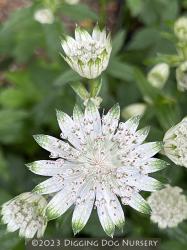
“Outstandingly strong and bold,” is how the late British garden writer Christopher Lloyd referred to this ornate gem. Especially long, soft-looking white bracts that are fringed with green, cradle the delicate, frosty pale pink corsages and gain ‘Shaggy’ its name. Planted en masse and superimposed against Actaea ‘Brunette’, the sturdy striated stems and deeply lobed spring green leaves project a verdurous mood.
Blooms June–August
Size: 2-1/2' high x 2' 0" wide.
Hardy to zone 5.
Astrantia major ‘Snow Star’ (P-2133)
Each $14.00
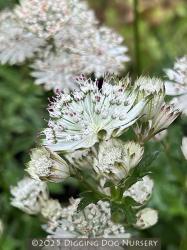
A temptress to pollinators and florists, the galaxy of luminous, domed umbels showcases white florets subtended by fancy ruffs with papery, green-tipped white bracts. Staunch upright stems yield orderly green leaves, which are palmately hewn into mostly, 5 toothed lobes beneath the long-lasting frosty display. Touting larger flowers than ‘Shaggy’, this stellar 2002 Aad Geerlings introduction can be ensconced amid Geranium ‘Birch Lilac’, Campanula ‘Prichard’s Variety’ and Salvia ‘Sweet Anja’.
Blooms mid June–September
Size: 2' 0" – 2-1/2' high x 15" – 18" wide.
Hardy to zone 5.
Once dubbed Plant of the Week and described as “a brooding, Victoria-plum-colored version of a cottage garden favorite” by British Guardian columnist Lia Leendertz, ′Venice′ unleashes ravishing pollinator-friendly wine-red umbels. Garbed with glistening green leaves that are palmately-hewn into attractive toothed lobes, the sturdy upright stems elevate copious, pincushion-like florets lodged atop a decorative ruff of persistent, pointed reddish purple bracts. This medium-sized perennial can be added to cut creations, sun-dappled borders, beds under trees, natural-style gardens and stream banks, where it detests root disturbance, craves adequate moisture and makes a dynamic statement amid acid-yellow blooming Euphorbias or Alchemilla.
Blooms mid-June–September
Size: 18" – 2' 0" high x 18" – 2' 0" wide.
Hardy to zone 5.
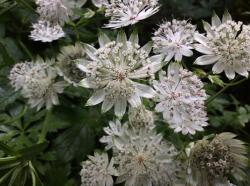
Slightly reminiscent of a sophisticated Queen Ann’s Lace, large mounded greenish white flowers reside atop a firm spidery ruff of green-tinged white bracts, while riding wiry stems and toothed, palmately cut dark green leaves. Coveted by butterflies, floral designers and horticulturists, ‘White Giant’ emphasizes long-lasting blooms with mesmerizing detail and a lovely enduring presence that can be sprinkled amongst Sesleria ‘Greenlee’, Geranium ‘Orion’ and Aster ‘October Skies’ for natural panache.
Blooms mid-June–September
Size: 2' 0" – 2-1/4' high x 12" – 15" wide.
Hardy to zone 5.
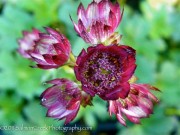
Resembling an elaborate centerpiece, mounded flower heads, backed in pale green and tipped in burgundy, make a glittery appearance on stiff, pointed inky-maroon bracts . This darkly colored base is unique and sets ‘Moulin Rouge’ apart from other Astrantia cultivars. Strong supple stems and glossy, deep cut greenery give way to the opulent pageant of large, long-blooming inflorescences that cast their beguiling spell upon the garden (pp#16549)
Blooms June–August
Size: 18" high x 18" wide.
Hardy to zone 4.
Athyrium
Lady Fern
Our highly ornamental offerings of this genus fashion remarkable fronds sprouting from a deciduous clump that relishes shady damp recesses. Old leaves can be left standing throughout the winter and cut back in the spring, just after the new ones burst forth.
Athyrium filix-femina ‘Lady in Red’ (F-0022)
Each $13.00
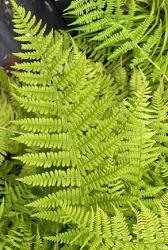
We applaud the New England Wildflower Society for discovering this fantastic sturdy form of the native Lady Fern, which roams the eastern and central areas of our country. Forging an elegant vase shape, uniquely colored red-violet stems are hard to miss and look especially vibrant against artful light green, lacy foliage. The dense deciduous clump maintains a fresh appearance as new delicate-looking leaves unfurl throughout the growing season. Unfazed by deer, rabbits and poor clay soil, easily maintained ‘Lady in Red’ spreads gradually and lends bold colorful accents to perennial plantings or woodland gardens.
Size: 18" – 3' 0" high x 18" – 2-1/2' wide.
Hardy to zone 4.
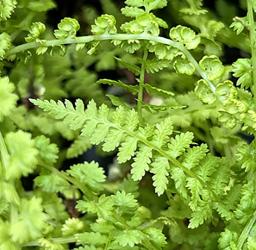
Coined the Queen of Green and touted as the “most spectacular of all cultivars” by Dr. John Mickel, former curator of ferns at the New York Botanical Garden, this lush refined fern was discovered in Scotland during the Victorian Fern Craze in 1861. A vigorous mossy-green delight, ‘Victoriae’s filigreed fronds sport a close-knit circular style, featuring pendulous tassel-like crested tips plus criss-crossed pinnae, which form a unique “X” pattern. Lady Fern’s amenable medium-sized guise lends luxe lacy accents to a patio container or woodland path, where it endures wet feet, detests clay and cherishes bright shade plus organic-rich soil.
Size: 18" – 2' 0" high x 18" – 2' 0" wide.
Hardy to zone 4.
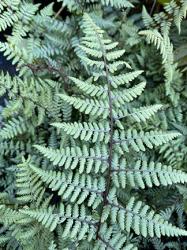
This hauntingly beautiful hybrid inherits stellar attributes from each parent, A. niponicum var. pictum and A. filix-femina, thanks to the breeding efforts of Virginia’s Nancy Swell. Strutting a straight-up formal stance, delicate-looking silver-laced new fronds continue to unfurl throughout the season alongside mature leaves that present soft pewter hues, celadon greens and burgundy accents. Easily grown 'Ghost' illuminates woodland shadows with subtle lacy shimmers and a reliable sturdiness.
Size: 2' 0" – 3' 0" high x 18" – 2' 0" wide.
Hardy to zone 4.
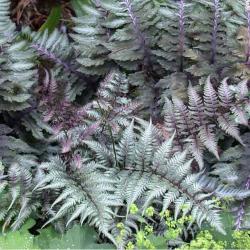
Hailing from eastern Asia, this ultra-refined deciduous fern hosts a posh arching rosette of lance-shaped bipinnate steel-gray leaves with green highlights, purplish red stems plus maroon-hued veins. Easy-care ‘Metallicum’ turns more green when the weather warms, wards off bunnies as well as deer and asserts glittering metallic panache to shady borders plus courtyards, shrub understory, woodlands and water’s edge. A sheltered, moist humus-rich alcove that’s fertile and well-drained guarantees a robust colony.
Size: 15" – 2' 0" high x 15" – 2' 0" wide.
Hardy to zone 4.
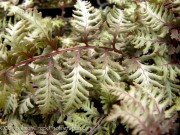
In stunning painterly strokes, olive-greens, blues and metallic silvers are splashed across the elegant tapered fronds. garnet-colored midribs etch a fervid counterpoint. Renown for its unwavering hardiness, the ever popular japanese painted fern slowly spreads to form a low growing, textural clump that gracefully weeps, softening the edges along paths, containers or the rockery and electrifying the shadows with Carex ‘Island Brocade’, Brunnera ‘Jack Frost’ and Pulmonaria longifolia ssp. cevennensis.
Tolerant of some drought once established, this refined deciduous fern fancies shade, moisture and well draining, humus-rich soil.
Size: 18" high x 2' 0" wide.
Zone 3/4.
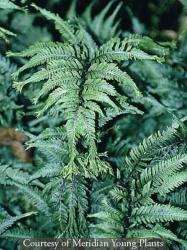
Named for the British nursery where it originated, this classy deciduous fern boasts a fanciful cresting that distinctively enhances the sides and tips of each leaf. Graceful arching triangular fronds with dark maroon midribs are bathed in tranquil gray, silver and green shades. Forging a dense colony over time from branching rhizomes, easy-care ‘Apple Court’ casts refined accents beneath shrubs and along shady paths, ponds or streams, where it adores organic-rich evenly-moist soil plus snubs deer and rabbits.
Size: 12" – 18" high x 12" – 18" wide.
Hardy to zone 4.
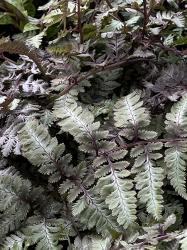
A dazzling lacy delicacy for the shadows, this bold deciduous Terra Nova introduction initially unfurls curving lance-shaped burgundy-violet fronds brightened by mercury-hued streaks along the veins and the tips. The graceful, yet tenacious clump matures with prominent purple mid-ribs set against a lustrous silvery-green foil. Tolerant of deer, rabbits, most diseases, wet soil and clay, ‘Burgundy Lace’ can be featured in borders, wooded plantings, cottage gardens and containers plus along streams or ponds, where it enjoys shade, good drainage, adequate moisture and fertile, organically rich abodes. (PP#15,072)
Size: 18" – 2' 0" high x 18" – 2' 0" wide.
Hardy to zone 5.
Gleaming with metallic highlights plus lavish burgundy-infused stems and veins, the arching triangular smoky-green fronds are a study in elegance. ′Red Beauty′s short branched rhizomes nourish the broad slow-spreading mound that forms a substantial easily maintained colony over time. Undeterred by deer, bunnies and most pests, this posh deciduous fern craves the shadows of adequately moist alcoves, where its feathery fine-hewn textures offset broad-leafed perennials such as Epimedium and Asarum to great effect.
Size: 12" – 18" high x 12" – 18" wide.
Hardy to zone 4.
Living up to its name, this swank Casa Flora selection boasts reliable color, beguiling texture and vigor aplenty. The fronds’ luminous silver-washed margins sparkle against posh, dark violet-red interiors, while somewhat twisting pinnules render an elegant ruffled appearance. Lasting well into fall and tolerant of occasional drought once established, undemanding ‘Regal Red’ can be featured in cut arrangements or squire fellow shade lovers such as Mukdenia, Begonia ‘Heron’s Pirouette’ and Pieris ‘Little Heath’.
Size: 12" – 18" high x 18" – 2' 0" wide.
Hardy to zone 4.
Gracefully arching maroon stems plus mature, triangular pewter-green fronds set the stage for an eye-catching two-toned effect as the new growth unfurls in nearly iridescent lime-green hues. A lover of dappled shade and regular water, this extraordinary upright Asian fern makes a vivacious long-lived specimen for the darker recesses of your garden, where she remains evergreen in milder climates, weds well with Aruncus ‘Horatio’ and appreciates protection from hot sun.
Size: 18" high x 2' 0" wide.
Zone 5/6.









